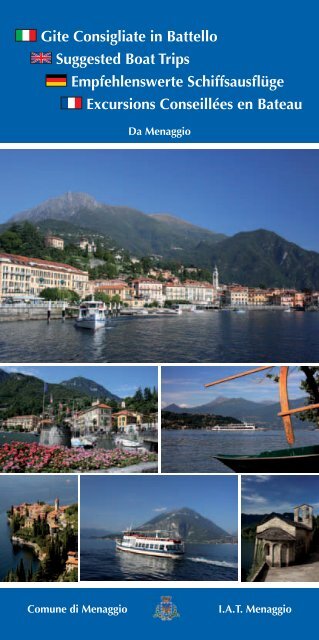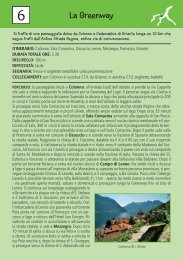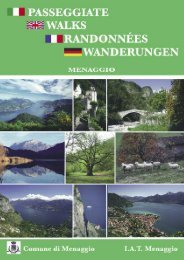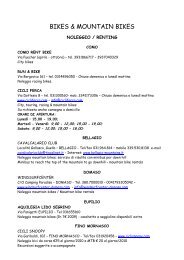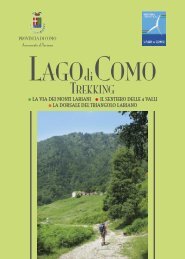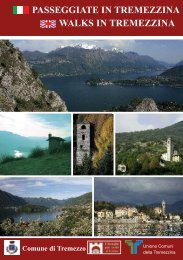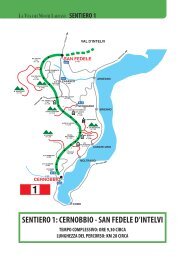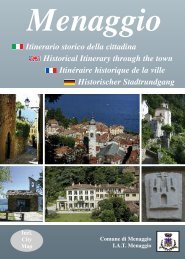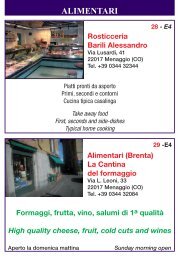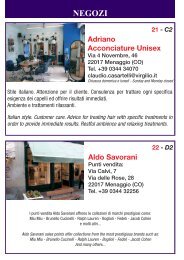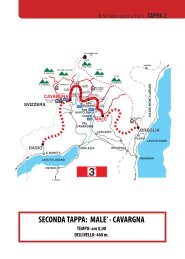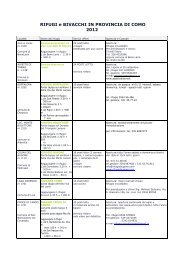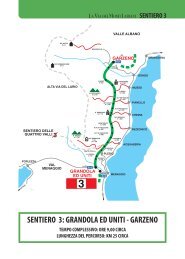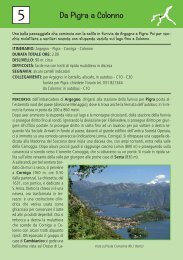Itinerari in battello in PDF - Comune di Menaggio
Itinerari in battello in PDF - Comune di Menaggio
Itinerari in battello in PDF - Comune di Menaggio
You also want an ePaper? Increase the reach of your titles
YUMPU automatically turns print PDFs into web optimized ePapers that Google loves.
Gite Consigliate <strong>in</strong> Battello<br />
Suggested Boat Trips<br />
Empfehlenswerte Schiffsausflüge<br />
Excursions Conseillées en Bateau<br />
Da <strong>Menaggio</strong><br />
<strong>Comune</strong> <strong>di</strong> <strong>Menaggio</strong><br />
I.A.T. <strong>Menaggio</strong>
© 2011 A. Sampietro<br />
GITE CONSIGLIATE IN BATTELLO Le l<strong>in</strong>ee <strong>di</strong> navigazione sul Lago<br />
<strong>di</strong> Como, sono dotate <strong>di</strong> battelli, traghetti ed aliscafi che consentono facili<br />
spostamenti tra le opposte sponde del Lario. È consigliabile utilizzare<br />
la via d’acqua, per meglio cogliere le bellezze della riviera, lontano<br />
del caos delle strade. Si suggerisce <strong>di</strong> acquistare i biglietti <strong>di</strong> libera<br />
circolazione, reperibili presso le biglietterie della Navigazione Laghi, con<br />
i quali è possibile sostare <strong>in</strong> più località; ad esempio il biglietto Centro<br />
Lago comprende i paesi <strong>di</strong>: <strong>Menaggio</strong>, Varenna, Bellagio, Cadenabbia,<br />
Tremezzo e Lenno, comodamente visitabili utilizzando sia i battelli che i<br />
traghetti (l’uso dell’aliscafo prevede <strong>in</strong>vece un supplemento). Esiste <strong>in</strong>oltre<br />
il biglietto cumulativo, che consiste <strong>in</strong> un biglietto <strong>di</strong> libera circolazione<br />
+ <strong>in</strong>gresso alla villa Carlotta. Per ulteriori <strong>in</strong>formazioni consultate www.<br />
navigazionelaghi.it<br />
SUGGESTED BOAT TRIPS The shores of Lake Como are still today<br />
a succession of small towns with ancient stone bell towers and sumptuous<br />
villas. In order to have a good vision of the beauties of the “Riviera” we<br />
highly recommend us<strong>in</strong>g the public boats. We recommend the day tickets<br />
that allow you to use boats as well as the ferries and visit more than one<br />
town with the same ticket. You may travel on the hydrofoils with this type<br />
of ticket but this implies pay<strong>in</strong>g a supplement. The central lake ticket for<br />
example <strong>in</strong>cludes <strong>Menaggio</strong>, Varenna, Bellagio, Cadenabbia, Tremezzo<br />
and Lenno. There is also an <strong>in</strong>terest<strong>in</strong>g comb<strong>in</strong>ed ticket: day ticket +<br />
entrance to Villa Carlotta. You can buy tickets at the Navigazioni Lago<br />
<strong>di</strong> Como ticket offices at the local boat land<strong>in</strong>gs. For more <strong>in</strong>formation<br />
consult www. navigazionelaghi.it
EMPFEHLENSWERTE SCHIFFSAUSFLÜGE Die Schifffahrtsl<strong>in</strong>ien<br />
auf dem Comer See mit Ausflugsbooten, Fährschiffen und Tragflügelbooten<br />
s<strong>in</strong>d e<strong>in</strong>e willkommene Abwechslung zu den oft überfüllten Uferstraßen.<br />
Schnell und mühelos erreicht man <strong>di</strong>e Städtchen am gegenüberliegenden<br />
Ufer und kann dabei das Panorama der zauberhaften Riviera genießen.<br />
Wir empfehlen Ihnen <strong>di</strong>e Tageskarte, mit der man sowohl mit dem Schiff<br />
(Tickets für Tragflächenboote gegen Aufschlag) als auch mit der Fähre,<br />
mehrere Orte anfahren kann. Zum Beispiel enthält das Billet „Centro<br />
Lago” <strong>Menaggio</strong>, Varenna, Bellagio, Cadenabbia, Tremezzo und Lenno.<br />
Es gibt außerdem auch <strong>di</strong>e folgende Kombikarte: Tageskarte + E<strong>in</strong>tritt<br />
zur Villa Carlotta. Die Fahrkarten löst man an den Schaltern der örtlichen<br />
Anlegestellen Mehr Auskunft auf dem Website der Navigazione lago <strong>di</strong><br />
Como www.navigazionelaghi.it .<br />
EXCURSIONS CONSEILEES EN BATEAU Les rives du Lac de<br />
Com sont une succession de petits villages avec clochers de pierre et<br />
somptueuses villas antiques. Pour mieux admirer les beautés de la riviera<br />
nous vous conseillons d’utiliser le bateau. Il y a des billets journaliers de<br />
libre circulation, à acheter aux guichets de la « Navigazione Laghi ». Il<br />
permet la visite de plusieurs villages en bateau ou en ferry (payer un<br />
supplément pour les hydroglisseurs) avec le même billet. Example billet<br />
“Centro Lago” comprend <strong>Menaggio</strong>, Varenna, Bellagio, Cadenabbia,<br />
Tremezzo et Lenno. Il y a aussi le billet cumulatif : Billet journalier de libre<br />
circulation + l’entrée à la Villa Carlotta<br />
Plus <strong>in</strong>formation sur le site www.navigazionelaghi.it
Como<br />
La splen<strong>di</strong>da gita da <strong>Menaggio</strong> a<br />
Como, che dura ca. due ore, vi permette<br />
<strong>di</strong> ammirare le bellissime ville<br />
e paesi che si affacciano su questo<br />
ramo del lago, godendo <strong>di</strong> scorci<br />
paesaggistici suggestivi, impossibili<br />
da cogliere viaggiando <strong>in</strong> auto lungo<br />
la costa.<br />
Il centro <strong>di</strong> Como, situato all’<strong>in</strong>terno<br />
delle antiche mura me<strong>di</strong>evali, è<br />
ricco <strong>di</strong> monumenti e opere d’arte:<br />
sulla suggestiva piazza del Duomo<br />
si erge il Broletto, l’antico palazzo<br />
comunale del 1200 con accanto la<br />
torre campanaria. Il Duomo fu costruito<br />
tra la f<strong>in</strong>e del 1300 e la metà<br />
del 1700, un vero gioiello che raccoglie<br />
<strong>in</strong> se <strong>di</strong>versi stili architettonici.<br />
Magnifiche sono le statue della sua<br />
facciata.<br />
Alle spalle del duomo sorge l’ex<br />
Casa del Fascio, capolavoro<br />
dell’architetto razionalista Giuseppe<br />
Terragni, considerata il simbolo<br />
dell’architettura moderna.<br />
Dell’epoca romanica sono conservate<br />
gran<strong>di</strong> chiese come S. Fedele,<br />
S. Abbon<strong>di</strong>o, S. Carpoforo.<br />
Vic<strong>in</strong>o al lago si trova il tempietto<br />
Voltiano <strong>di</strong> stile neoclassico, eretto<br />
nel 1927 per il primo centenario<br />
della morte <strong>di</strong> Alessandro Volta,<br />
orig<strong>in</strong>ario <strong>di</strong> Como, e, accanto, il<br />
Monumento ai Caduti, <strong>in</strong>nalzato<br />
nel 1933 su <strong>di</strong>segno dell’architetto<br />
futurista Antonio Sant’Elia.<br />
La passeggiata sul lungo lago da<br />
Piazza Cavour ai giard<strong>in</strong>i <strong>di</strong> Villa<br />
Olmo permette <strong>di</strong> ammirare le bellissime<br />
ville neoclassiche che sorgono<br />
sulle rive. Sulla piant<strong>in</strong>a della<br />
città <strong>di</strong> Como, reperibile presso l’ufficio<br />
<strong>in</strong>formazioni, vengono descritti<br />
i monumenti più importanti della città.<br />
Ogni sabato e martedì e giovedì<br />
(solo al matt<strong>in</strong>o), si svolge il mercato<br />
lungo le antiche mura.<br />
Per ammirare dall’alto la città e<br />
l’area comasca del Lario, si consiglia<br />
<strong>di</strong> prendere la funicolare per<br />
Brunate.<br />
The splen<strong>di</strong>d 2 hour boat trip from<br />
<strong>Menaggio</strong> to Como, gives you the<br />
possibility to admire Lake Como’s<br />
beautiful villas situated ma<strong>in</strong>ly on<br />
this branch of the lake and <strong>di</strong>fficult<br />
to see from the road.<br />
Como’s centre, located <strong>in</strong>side the<br />
antique me<strong>di</strong>eval walls, is rich <strong>in</strong><br />
monuments and artworks. In the piazza<br />
del Duomo (cathedral) you f<strong>in</strong>d<br />
the Broletto, the antique town hall<br />
built <strong>in</strong> 1200 and the town’s bell tower.<br />
The Duomo was built between<br />
the end of 1300 and the mid 1700’s<br />
and is a fusion of <strong>di</strong>fferent architectural<br />
styles. The façade statues are<br />
astonish<strong>in</strong>g.<br />
Beh<strong>in</strong>d the Duomo is the ex Casa<br />
del Fascio masterpiece of the rationalist<br />
architect Giuseppe Terragni<br />
considered the symbol of modern<br />
architecture.<br />
Como also hosts real gems of<br />
the Romanesque period like the<br />
church of S. Fedele, S. Abbon<strong>di</strong>o,<br />
S. Carpoforo.<br />
Near the lake stands the neoclassic<br />
Voltiano temple erected <strong>in</strong> 1927 for<br />
the centennial of the death of Alessandro<br />
Volta, the <strong>in</strong>ventor of the<br />
battery, born <strong>in</strong> Como. Next to the<br />
temple is the War Memorial constructed<br />
<strong>in</strong> 1933 based on the designs<br />
of futuristic architect Antonio<br />
Sant’Elia.<br />
Walk from Piazza Cavour to the gardens<br />
of Villa Olmo <strong>in</strong> order to admire<br />
the beautiful neoclassical villas<br />
on the lake shore.<br />
On the town map of Como, available<br />
at the Tourist Office, the ma<strong>in</strong><br />
monuments are <strong>in</strong><strong>di</strong>cated. Every<br />
Saturday. Tuesday and Thursday<br />
(morn<strong>in</strong>g only) there is a big market<br />
along the ancient city walls.<br />
A ride with the funicular to Brunate<br />
gives you an extraord<strong>in</strong>ary view of<br />
the town.
Como<br />
Der schöne 2 Stunden lange<br />
Schiffsauflug ab <strong>Menaggio</strong> nach<br />
Como bietet <strong>di</strong>e Möglichkeit <strong>di</strong>e viele<br />
Villen, <strong>di</strong>e am Seeufer liegen, und<br />
von der Straße aus kaum sichtbar<br />
s<strong>in</strong>d, zu bewundern.<br />
Das Zentrum von Como, das sich<br />
zwischen den alten mittelalterlichen<br />
Stadtmauern bef<strong>in</strong>det, ist reich an<br />
Kunst und Monumenten. Auf der<br />
schönen Piazza del Duomo steht das<br />
Broletto, das alte Rathaus aus dem<br />
12. Jh. mit dem daneben stehenden<br />
Glockenturm. Der Dom wurde<br />
zwischen 1300 und 1700 gebaut<br />
und ist e<strong>in</strong>e Mischung verschiedener<br />
architektonischer Stile.<br />
H<strong>in</strong>ter dem Dom steht <strong>di</strong>e ehemalige<br />
„Casa del Fascio“, Meisterwerk<br />
des Architekten Giuseppe Terragni,<br />
das als Symbol moderner Architektur<br />
gesehen wird.<br />
Aus der romanischen Periode gibt<br />
es <strong>di</strong>e wunderbaren Kirchen von S.<br />
Fedele, S. Abbon<strong>di</strong>o, S. Carpoforo.<br />
In der Seenähe gibt es den Voltiano<br />
Tempel, der 1927, zur Feier des <strong>in</strong><br />
Como geborenen Wissenschaftlers<br />
Alessandro Volta, errichtet<br />
wurde. Gleich daneben steht das<br />
Monument zum Gedenken an<br />
<strong>di</strong>e gefallen Soldaten, Projekt des<br />
futuristischen Architekten Antonio<br />
Sant’Elio.<br />
Es empfiehlt sich, <strong>di</strong>e Wanderung<br />
von Piazza Cavour am See<br />
entlang zu den Gärten der Villa<br />
Olmo, um so <strong>di</strong>e neoklassischen<br />
Villen bewundern zu können. Im<br />
Tourismusbüro s<strong>in</strong>d Stadtpläne<br />
von Como mit Erklärungen der<br />
Monumente erhältlich. Am Samstag<br />
und am Dienstag und Donnerstag<br />
(vormittags) gibt es entlang der<br />
Stadtmauern Comos e<strong>in</strong>en Markt.<br />
E<strong>in</strong>e Fahrt mit der Drahtseilbahn<br />
von Como nach Brunate bietet<br />
e<strong>in</strong>en herrlichen Blick auf Como und<br />
den See.<br />
La jolie croisière de <strong>Menaggio</strong> à<br />
Come, que dure deux heures, vous<br />
permet d’admirer les splen<strong>di</strong>des<br />
villas et les villages qui se trouvent<br />
sur les rives de ce bras du lac et qui<br />
sont peu visibles de la route.<br />
Le centre de Côme, situé entre les<br />
murs mé<strong>di</strong>évaux, est riche en monuments<br />
et oeuvres d’art: Sur la<br />
place de la cathédrale on trouve le<br />
Broletto, l’ancien palais de la Mairie<br />
érigé en 1215. La cathédrale fut<br />
é<strong>di</strong>fiée entre 1300 et 1700, un vrais<br />
bijou qui recueille <strong>di</strong>fférents styles<br />
architecturaux. Les décorations de<br />
la façade et les portails sont magnifiques.<br />
Derrière la cathédrale on trouve Palazzo<br />
Terragni, réalisé par l’architecte<br />
Terragni entre 1932 et 1936,<br />
considéré comme une étape fondamentale<br />
de l’architecture moderne.<br />
Les églises de San Fedele, S. Abbon<strong>di</strong>o<br />
et S. Carpoforo sont de<br />
beaux exemples de construction<br />
romane.<br />
Près du lac on trouve le Temple<br />
Voltiano qui fut bâti en 1927 en<br />
style néoclassique. Il conserve les<br />
<strong>in</strong>struments qu’ Alessandro Volta,<br />
né à Come, utilisa pour ses études<br />
et la fameuse pile électrique. A coté<br />
se trouve le Monument Mémorial<br />
réalisé en 1927 par l’architecte futuriste<br />
Sant’Elia.<br />
On conseille la promenade depuis<br />
Piazza Cavour à la Villa Olmo au<br />
bord du lac ou on peut admirer plusieurs<br />
villas néoclassiques. A l’Office<br />
du Tourisme on trouve le plan<br />
de la ville avec la description de<br />
tous les monuments importants. Le<br />
marché a lieu les same<strong>di</strong>s (toute la<br />
journée), les mar<strong>di</strong>s mat<strong>in</strong> et jeu<strong>di</strong>s<br />
mat<strong>in</strong>s. On conseille de prendre le<br />
funiculaire pour Brunate, d’où on<br />
jouit d’une vue superbe sur la première<br />
partie du lac et de la ville.
Bellagio<br />
Bellagio, sorge sull’estremità del<br />
promontorio che fa da spartiacque<br />
tra il ramo <strong>di</strong> Como e il ramo<br />
<strong>di</strong> Lecco.<br />
All’estremità nord del paese si trova<br />
la panoramica Punta Spartivento<br />
che permette, con uno sguardo, <strong>di</strong><br />
abbracciare i tre rami del lago.<br />
La cima del promontorio è dom<strong>in</strong>ata<br />
da Villa Serbelloni, il quale<br />
parco si estende per l’<strong>in</strong>tero promontorio<br />
a monte del paese con<br />
una splen<strong>di</strong>da vista; è aperto da<br />
metà marzo a metà Novembre, tutti<br />
i giorni tranne il lunedì e le visite,<br />
unicamente guidate, hanno luogo<br />
due volte al giorno (ore 11.00 e<br />
ore 15.30): per i biglietti e le prenotazioni<br />
è necessario recarsi 15<br />
m<strong>in</strong>. prima dell’<strong>in</strong>izio della visita<br />
presso l’ufficio dell’Associazione<br />
Promobellagio, sito nella torre della<br />
piazza della chiesa 15 m<strong>in</strong>. prima<br />
della visita. Nella medesima torre,<br />
che costituisce l’unico avanzo<br />
dell’antico sistema <strong>di</strong>fensivo, si<br />
trova uno spazio espositivo. Nella<br />
stessa piazza si trova la basilica<br />
<strong>di</strong> San Giacomo, chiesa risalente<br />
all’XI secolo, pregevole esempio <strong>di</strong><br />
romanico lombardo.<br />
Proseguendo per circa 800 m verso<br />
sud dall’imbarcadero dei traghetti,<br />
si raggiungono i bellissimi giard<strong>in</strong>i<br />
<strong>di</strong> Villa Melzi, aperti dalle 9.30 alle<br />
18.30, da f<strong>in</strong>e marzo a f<strong>in</strong>e ottobre.<br />
Anche questa residenza nobiliare<br />
ebbe tra i suoi ospiti personalità famose<br />
dagli imperatori Francesco I<br />
e Ferd<strong>in</strong>ando d’Austria al musicista<br />
Franz Liszt. Il pieghevole “Ville e<br />
Giard<strong>in</strong>i del Centro Lago” contiene<br />
nei dettagli la storia <strong>di</strong> queste ville.<br />
Gli appassionati dello shopp<strong>in</strong>g<br />
non rimarranno delusi perché nelle<br />
strad<strong>in</strong>e caratteristiche del piccolo<br />
borgo, e su per la famosa Salita<br />
Serbelloni, troveranno boutiques e<br />
negozi con articoli artigianali. Per<br />
conoscere al meglio il centro <strong>di</strong><br />
Bellagio chiedete l’it<strong>in</strong>erario storico<br />
all’ufficio <strong>in</strong>formazioni.<br />
Bellagio is situated on the watershed<br />
pen<strong>in</strong>sula that <strong>di</strong>vides the two<br />
branches of the lake. Its extraord<strong>in</strong>ary<br />
position, its little alleys like<br />
the Salita Serbelloni with numerous<br />
shops with local handcraft, the<br />
superb villas make it an enchant<strong>in</strong>g<br />
place.<br />
Villa Serbelloni located on top<br />
of the peaked headland, has the<br />
lake’s largest park with a splen<strong>di</strong>d<br />
view of the two branches of the<br />
Lake. It is open every day, apart<br />
from Monday from mid March till<br />
mid November. The visits, only<br />
guided, take place twice a day at<br />
11.00 and at 15.30; reservations<br />
for the visit must be made at the<br />
Promobellagio office <strong>in</strong> the tower <strong>in</strong><br />
Piazza della Chiesa 15 m<strong>in</strong>. before<br />
the guided visit starts, max. 30 pax.<br />
The tower, one the few rema<strong>in</strong>s of<br />
Bellagio’s me<strong>di</strong>eval defence system,<br />
is also used for exhibitions.<br />
In the same Piazza stands the<br />
Basilica of S. Giacomo of the XI<br />
century, a good example of the<br />
Lombar<strong>di</strong>an Romanesque style. In<br />
able to know more about Bellagio’s<br />
monuments ask for the historic it<strong>in</strong>erary<br />
through the town.<br />
At the northern end of the town is<br />
the panoramic Punta Spartivento<br />
that offers a view of all three arms<br />
of the lake.<br />
About 800 m south of the car ferry<br />
land<strong>in</strong>g are the beautiful gardens<br />
of Villa Melzi open from the end of<br />
March till the end of October from<br />
9.30 till 18.30. Described by Stendhal,<br />
also this noble residence had<br />
among its guests famous personalities:<br />
from the Emperors Francesco<br />
I and Ferd<strong>in</strong>and of Austria to the<br />
musician Liszt.<br />
The leaflet “Villas of the Central<br />
Lake area” gives you the history of<br />
the villas.
Bellagio<br />
Bellagio liegt an der Spitze der<br />
Halb<strong>in</strong>sel, <strong>di</strong>e den Comer See <strong>in</strong><br />
zwei Arme teilt. Das Dörfchen mit<br />
se<strong>in</strong>en Treppengassen mit vielen<br />
Läden – ideal für Shopp<strong>in</strong>gliebhaber<br />
– se<strong>in</strong>en kle<strong>in</strong>en Plätzen und<br />
schönen Villen, zieht viele Besucher<br />
an.<br />
Auf dem Gipfel der Halb<strong>in</strong>sel steht<br />
<strong>di</strong>e Villa Serbelloni mit e<strong>in</strong>em<br />
wunderbaren Park, der sich am<br />
ganzen Hang oberhalb vom Ort,<br />
mit wunderbarer Sicht auf beide<br />
Seearme, ausdehnt. Der Park der<br />
Villa ist vom Mitte März bis Mitte<br />
November täglich außer montags<br />
geöffnet. Es gibt nur geführte Besichtigungen<br />
– zweimal pro Tag,<br />
und zwar um 11.00 Uhr und um<br />
15.30 Uhr Reservierung und Karten<br />
gibt es 15 M<strong>in</strong>. vor Beg<strong>in</strong>n der<br />
Besichtigung im Büro der Promobellagio<br />
im Turm an der Piazza<br />
della Chiesa. Dieser Turm ist der<br />
e<strong>in</strong>zige Überrest des mittelaltelichen<br />
Vertei<strong>di</strong>gungssystems von<br />
Bellagio. Auf der gleichen Piazza<br />
steht <strong>di</strong>e Basilica von S. Giacomo<br />
aus dem XI Jh, e<strong>in</strong>s der besten<br />
Esemplare der romanisch-lombar<strong>di</strong>schen<br />
Kunst. Weitere Infos gibt<br />
es im Kunst- und Geschichtsführer<br />
von Bellagio.<br />
Am Nordende des Ortes bef<strong>in</strong>det<br />
sich <strong>di</strong>e „Punta Spartivento“<br />
(W<strong>in</strong>dscheide). Hier bietet sich<br />
dem Besucher e<strong>in</strong>s der schönsten<br />
Panoramas des Sees, dort, wo <strong>di</strong>e<br />
Spitze den Comer See <strong>in</strong> se<strong>in</strong>e drei<br />
Seearme teilt.<br />
Etwa 800 m südlich der Autofähranlegestelle<br />
gibt es <strong>di</strong>e wunderbaren<br />
Gärten der Villa Melzi; täglich<br />
geöffnet vom Ende März bis Ende<br />
Oktober von 9.30 bis 18.30 Uhr. Es<br />
gibt tropische und exotische Planzen,<br />
wertvolle Skulpturen sowie<br />
e<strong>in</strong>en japanisch angelegten Teich.<br />
Fragen Sie nach der Broschüre<br />
über <strong>di</strong>e Villen.<br />
Bellagio est connu dans le monde<br />
entier comme «la perle du Lac de<br />
Côme» et se trouve sur la pén<strong>in</strong>sule<br />
qui sépare les deux parties du<br />
lac, soit le bras allant sur Côme soit<br />
le bras allant vers Lecco. La Villa<br />
Serbelloni dom<strong>in</strong>e ce promontoire.<br />
Pour le parc - du moitié Mars<br />
au moitié Novembre - visite deux<br />
fois par jour avec guide - à 11h et<br />
à 15h.30 (30 personnes maximum)<br />
la visite est limitée au parc. Fermé<br />
le lun<strong>di</strong> et en cas de mauvais<br />
temps. Se présenter 15 m<strong>in</strong>utes<br />
avant l’heure, au bureau de la Promobellagio<br />
qui se trouve au rezde-chaussée<br />
de la tour mé<strong>di</strong>évale<br />
située sur la place de l’église (dans<br />
la partie haute de Bellagio).<br />
Sur la même place on trouve<br />
l’église S. Giacomo bâtie en XI<br />
siècle, un importants exemples de<br />
monuments romans. Demandez la<br />
brochure avec l’it<strong>in</strong>éraire historique<br />
de Bellagio avec le plan.<br />
La po<strong>in</strong>te extrême nord du village,<br />
appelée Punta Spartivento (la<br />
po<strong>in</strong>te qui <strong>di</strong>vise le vent) offre un<br />
des meilleurs panoramas du lac.<br />
En se promenant le long du lac<br />
vers le sud on peut arriver aux magnifiques<br />
jard<strong>in</strong>s de la Villa Melzi,<br />
ceux-ci sont accessibles de 9h.30<br />
à 18h30 de f<strong>in</strong> de mars au f<strong>in</strong> d’octobre.<br />
Elle a vu passer des personnages<br />
comme les empereurs d’Autriche<br />
Francesco I et Ferd<strong>in</strong>ando<br />
et puis encore le musicien Liszt.<br />
Demander la petite brochure <strong>in</strong>titulée<br />
“Les Villas du Centre du Lac”<br />
qui donne la description et l’histoire<br />
des villas.<br />
Les amateurs de shopp<strong>in</strong>g ne seront<br />
pas déçus par les multiples<br />
boutiques et magas<strong>in</strong>s d’articles<br />
d’artisanat régional qui se trouvent<br />
dans les petites ruelles et sous les<br />
arcades de ce bourg.
Varenna<br />
Una traversata <strong>in</strong> <strong>battello</strong> da <strong>Menaggio</strong><br />
a Varenna, offre uno dei<br />
panorami più spettacolari <strong>di</strong> tutto<br />
il Lario, poiché si percorre l’area<br />
d’<strong>in</strong>contro dei tre rami che compongono<br />
il lago.<br />
Il borgo <strong>di</strong> Varenna, con le sue<br />
coloratissime case, è arroccato al<br />
monte dom<strong>in</strong>ato dal castello <strong>di</strong> Vezio.<br />
Dall’imbarcadero, costeggiando<br />
il lago sulla destra, si percorre<br />
la panoramica “Passeggiata degli<br />
Innamorati” che porta al centro del<br />
paese.<br />
A Varenna sorgono ville gran<strong>di</strong>ose<br />
delle quali è possibile visitare i giard<strong>in</strong>i<br />
caratterizzati dalla presenza <strong>di</strong><br />
numerosi cipressi e <strong>di</strong> rare essenze<br />
me<strong>di</strong>terranee, come quelli <strong>di</strong><br />
Villa Cipressi e <strong>di</strong> Villa Monastero;<br />
quest’ultimo è aperto da <strong>in</strong>izio<br />
aprile f<strong>in</strong>o alla f<strong>in</strong>e <strong>di</strong> ottobre e visitandolo<br />
<strong>di</strong> sabato o <strong>di</strong> domenica è<br />
<strong>in</strong>oltre possibile accedere alla casa<br />
museo.<br />
Si gode <strong>di</strong> una bellissima vista dal<br />
Castello <strong>di</strong> Vezio, raggiungibile <strong>in</strong><br />
ca. 30 m<strong>in</strong>, salendo a pie<strong>di</strong> dall’imbarcadero.<br />
Il castello, risalente al<br />
1300, è visitabile dal 1 marzo al 1<br />
novembre dalle h 10 al tramonto,<br />
ed ospita al suo <strong>in</strong>terno un centro <strong>di</strong><br />
falconeria. Per sapere gli orari delle<br />
esibizioni <strong>di</strong> volo dei falchi consultate<br />
il sito www.castello<strong>di</strong>vezio.it.<br />
Da Vezio, un piccolo agglomerato<br />
<strong>di</strong> case costruite per la maggior<br />
parte <strong>in</strong> sasso, si può seguire il<br />
sentiero del Viandante, antica via<br />
<strong>di</strong> comunicazione, che <strong>in</strong> ca. 1.30<br />
ora conduce a Bellano.<br />
Si consiglia <strong>in</strong>oltre la passeggiata<br />
alla sorgente “Fiumelatte” (chiedete<br />
per il depliant con l’it<strong>in</strong>erario),<br />
un corso d’acqua che r<strong>in</strong>asce ogni<br />
anno <strong>in</strong> primavera da una grotta a<br />
monte e si getta spumeggiando nel<br />
lago dopo soli 250 m <strong>di</strong> percorso.<br />
The boat trip from <strong>Menaggio</strong> to<br />
Varenna gives you one of the most<br />
spectacular views of Lake Como as<br />
the boat crosses the middle of the<br />
lake, right there where its three 3<br />
branches meet.<br />
The peaceful town with its colourful<br />
houses is graciously woven <strong>in</strong>to the<br />
mounta<strong>in</strong> landscape dom<strong>in</strong>ated by<br />
the ru<strong>in</strong>s of the Castello <strong>di</strong> Vezio.<br />
From the boat dock to the right a<br />
romantic walk way called “Lover’s<br />
Lane” leads to the centre. The<br />
town hosts beautiful villas like Villa<br />
Monastero. In 2003 the <strong>in</strong>side of<br />
the villa became a museum with 14<br />
rooms furnished with orig<strong>in</strong>al objects<br />
and furniture. The villa stands<br />
<strong>in</strong> a magnificent park where citrus,<br />
cypresses, p<strong>in</strong>e trees and agaves<br />
grow and stretches over more than<br />
a kilometre. Close to Villa Monastero<br />
stands the Villa Cipressi built<br />
between 1400 and 1800 with a<br />
splen<strong>di</strong>d botanical gardens spread<br />
out over various levels.<br />
The castle of Vezio, built <strong>in</strong> the<br />
13th century, can be reached by<br />
foot (uphill) <strong>in</strong> approx. 30 m<strong>in</strong>. from<br />
the ferry dock. It is open to the public<br />
from 1 March till 1 November<br />
daily from 10 till sunset; closed <strong>in</strong><br />
case of bad weather. The castle<br />
hosts a falconry ; Ask for times of<br />
the flight exhibitions www.castello<strong>di</strong>vezio.it<br />
Vezio is a little built up<br />
area, mostly built of stone. From<br />
here you can walk along the Viandante,<br />
an ancient path way, <strong>in</strong><br />
1h30 to the town Bellano We also<br />
recommend the walk to the source<br />
of “Fiume Latte”, Italy’s shortest<br />
river. It spr<strong>in</strong>gs from a cavern <strong>in</strong> the<br />
mounta<strong>in</strong>s and it <strong>di</strong>sappears dur<strong>in</strong>g<br />
the w<strong>in</strong>ter; ask for leaflet with the<br />
it<strong>in</strong>erary.
Varenna<br />
© 2011 A. Sampietro<br />
Bei e<strong>in</strong>er Schiffsüberfahrt von <strong>Menaggio</strong><br />
nach Varenna kann man<br />
das herrlichste Panorama des<br />
Sees bewundern. Hier ist der Mittelpunkt<br />
der drei Seearme. Der Ort<br />
mit se<strong>in</strong>en farbigen Häusern ist<br />
zierlich <strong>in</strong> <strong>di</strong>e Berglandschaft gewoben<br />
und wird von den Ru<strong>in</strong>en<br />
des Castello <strong>di</strong> Vezio dom<strong>in</strong>iert.<br />
Ab der Schiffsanlegestelle führt<br />
rechts e<strong>in</strong>e romantische Seepromenade<br />
zum Zentrum mit se<strong>in</strong>en<br />
alten Kirchen sowie <strong>di</strong>e von S. Giovanni<br />
Battista des XII Jh. und <strong>di</strong>e<br />
Kirche S. Giorgio. Varenna birgt<br />
wunderschöne Villen wie <strong>di</strong>e Villa<br />
Monastero, mit e<strong>in</strong>em Garten der<br />
sich 1 km am See entlang ausdehnt.<br />
Im Jahre 2003 wird der Villa<br />
auch Museum. Es gibt im Inneren<br />
der Villa 14 Säle, <strong>di</strong>e komplett mit<br />
orig<strong>in</strong>alen Möbeln und Kunstobjekten<br />
ausgestattet s<strong>in</strong>d. Gleich<br />
daneben liegt <strong>di</strong>e Villa Cipressi,<br />
e<strong>in</strong> Bauwerk aus dem 16. Jh., mit<br />
herrlichen, zum See abfallendem<br />
Garten. (Öffnungszeiten im Faltblatt<br />
„Villen am Zentralen Teil des<br />
Sees“)<br />
Das Schloss Castello <strong>di</strong> Vezio,<br />
im 13. Jh. gebaut, kann man zu<br />
Fuß <strong>in</strong> ca. 30 M<strong>in</strong>. (ansteigend)<br />
ab der Schiffsanlegestelle, erreichen.<br />
Es ist täglich geöffnet vom<br />
1.3. bis 1.11. von 10.00 bis Sonnuntergang;<br />
bei schlechtem Wetter<br />
allerd<strong>in</strong>gs geschlossen. E<strong>in</strong> Besonderheit<br />
der Burg ist der Falkenhof;<br />
mit dressierten Raubvögeln, <strong>di</strong>e<br />
der Falkner dem Publikum an bestimmten<br />
Zeiten, meistens nachmittags<br />
(siehe www.castel<strong>di</strong>vezio.<br />
it) präsentiert.<br />
Ab Vezio, e<strong>in</strong> kle<strong>in</strong>es Dorf aus<br />
Ste<strong>in</strong>häusern, kann man auf der<br />
Viandante, e<strong>in</strong>em antiken Fahrweg,<br />
<strong>in</strong> etwa 1h30 Bellano erreichen.<br />
La traversée en bateau de <strong>Menaggio</strong><br />
à Varenna offre un des panoramas<br />
les plus spectaculaires de<br />
tout le Lario, quand on se trouve au<br />
centre des trois branches qui composent<br />
le Lac de Côme.<br />
Le centre ville, avec ses maisons<br />
très colorées, est niché dans la<br />
montagne dom<strong>in</strong>é par les ru<strong>in</strong>es<br />
du château de Vezio. De l’embarcadère<br />
on suit à droit la promenade<br />
romantique qui amène au centre<br />
ville avec ses églises anciennes<br />
comme cela de S. Giovanni Battista<br />
du10/11 éme siècle et l’église<br />
de San Giorgio. Même à Varenna<br />
on trouve de villas entourées de<br />
jard<strong>in</strong>s splen<strong>di</strong>des avec des cyprès<br />
et des nombreuses essences<br />
exotiques comme dans la Villa<br />
Monastero. Demander la petite<br />
brochure qui a pour titre «Les Villas<br />
du Centre du Lac». A coté de<br />
la Monastero on trouve la villa<br />
Cipressi, é<strong>di</strong>fice du 16 éme siècle.<br />
Le «Castello <strong>di</strong> Vezio» château du<br />
13 éme siècle, qu’on peut rejo<strong>in</strong>dre<br />
en 30 m<strong>in</strong> depuis l’embarcadère,<br />
offre une vue magnifique. Il peut<br />
être visité de 1 mars le same<strong>di</strong> au<br />
1 novembre tous les jours. Fermé<br />
les jours de mauvais temps. On y<br />
trouve une volerie de faucons et on<br />
peut assister à des démonstrations<br />
de vole (normalement l’après-mi<strong>di</strong><br />
- demander les horaires). Depuis<br />
Vezio, un petit hameau avec ses<br />
maisons typiques en pierre on<br />
peut suivre l’ancien chem<strong>in</strong> appelé<br />
Viandante, et en 1.30 heure<br />
atte<strong>in</strong>dre Bellano.Il est également<br />
conseillé de se promener à la<br />
source du fleuve «Fiumelatte»,<br />
le plus court d’Italie, demander la<br />
brochure.
Tremezzo<br />
Il paese si estende dalle rive del<br />
lago all’entroterra coll<strong>in</strong>are, ai pie<strong>di</strong><br />
del Monte Crocione. È caratterizzato<br />
<strong>in</strong>fatti da due anime, una rivierasca<br />
e l’altra coll<strong>in</strong>are, entrambe <strong>di</strong><br />
grande bellezza e suggestione.<br />
Tra le antiche <strong>di</strong>more signorili che<br />
sorgono numerose <strong>in</strong> questo luogo,<br />
spicca Villa Carlotta, e<strong>di</strong>ficata<br />
<strong>in</strong>torno al 1690, con il suo meraviglioso<br />
parco botanico ricco <strong>di</strong> varie<br />
specie arboree e floreali. Al suo <strong>in</strong>terno<br />
ha sede il museo omonimo,<br />
de<strong>di</strong>cato allo stile neoclassico. Vi<br />
sono conservate numerose e importanti<br />
opere d’arte, <strong>in</strong> particolare<br />
le sculture del Canova, <strong>di</strong>p<strong>in</strong>ti e<br />
stanze con arredamento d’epoca.<br />
Apertura: dal 17 marzo al 4 novembre<br />
tutti i giorni; da aprile a ottobre<br />
dalle h. 9.00 alle 18.00 marzo e novembre:<br />
dalle h. 10.00 alle 17.00.<br />
Un cent<strong>in</strong>aio <strong>di</strong> metri a sud dell’imbarcadero,<br />
si trova il parco pubblico<br />
Olivelli. Lo stile del parco è<br />
segnato dal gusto dell’architetto<br />
L<strong>in</strong>geri ed è visibile soprattutto<br />
nella scal<strong>in</strong>ata che congiunge le<br />
due parti del parco e nella grande<br />
e artistica fontana. Quasi <strong>di</strong>rimpetto<br />
al parco si trova l’ imponente<br />
chiesa parrocchiale <strong>di</strong> S. Lorenzo<br />
del 1896. Proseguendo lungo il<br />
lago si <strong>in</strong>travede la sontuosa villa<br />
La Quiete risalente al primo Settecento<br />
con l’antistante giard<strong>in</strong>o<br />
all’italiano.<br />
Si consiglia il bellissimo it<strong>in</strong>erario<br />
a pie<strong>di</strong> (chiedete il pieghevole) da<br />
Lenno a Tremezzo, attraversa gli<br />
antichi nuclei <strong>di</strong> Volesio, Viano e<br />
Balogno dove si trovano dei bei<br />
palazzi che appartenevano a potenti<br />
famiglie locali, che si arricchirono<br />
tra il ’600 e il ’700, commerciando<br />
nel nord Europa.<br />
Tremezzo extends itself between<br />
the shores of the lake and the<br />
beautiful hilly h<strong>in</strong>terland at the foot<br />
of Monte Crocione. Among the antique<br />
sumptuous villas that you f<strong>in</strong>d<br />
<strong>in</strong> the Tremezzo area outstands the<br />
world famous “Villa Carlotta” built<br />
around 1690 with its marvellous<br />
park with rare plants and trees of<br />
many k<strong>in</strong>ds. Also the <strong>in</strong>side of the<br />
villa, with its prom<strong>in</strong>ent art collection<br />
such as sculptures by Canova,<br />
pa<strong>in</strong>t<strong>in</strong>gs by Hayez, is open to the<br />
public. The gardens and villa are<br />
open from 17 March till 4 November<br />
daily; from April till the end of<br />
October from 9 am till 18 pm March<br />
and November from 10 am till<br />
17.pm.<br />
At the end of the town (<strong>di</strong>rection<br />
Como) almost opposite the impos<strong>in</strong>g<br />
parish church of S. Lorenzo of<br />
1896, is the public park Olivelli.<br />
The park is <strong>in</strong> the architectural rationalist<br />
style, which can be noticed<br />
<strong>in</strong> particular <strong>in</strong> the stairs which connect<br />
the two parts of the park and<br />
<strong>in</strong> the large artistic founta<strong>in</strong>. Just<br />
south of the park stands Villa la<br />
Quiete dat<strong>in</strong>g back to the beg<strong>in</strong>n<strong>in</strong>g<br />
of the XVIII century. Through<br />
its wrought iron gate you can admire<br />
its Italian garden The walk<br />
from Lenno to Tremezzo leads<br />
through the upper part of the town,<br />
through the rural villages of Volesio<br />
and Viano with their labyr<strong>in</strong>ths<br />
of narrow cobble stone streets and<br />
beautiful palaces built by rich local<br />
families who earned their fortune<br />
dur<strong>in</strong>g the 16 th and 17 th century as<br />
merchants <strong>in</strong> the northern part of<br />
Europe; ask for the route description.
Tremezzo<br />
Der Ort dehnt sich vom Seeufer<br />
bis h<strong>in</strong> zum hügeligen H<strong>in</strong>terland<br />
am Fuß des Monte Crocione aus.<br />
Im 18. Jh. war es Zeuge des „Tourismus<br />
der Villen“, der den Aufbau<br />
von majestätischen Gebäuden hervorbrachte,<br />
über welche <strong>di</strong>e Villa<br />
Carlotta, mit ihrem prachtvollen<br />
Park, reich an seltenen Pflanzen,<br />
emporragt. Im Inneren der Villa ist<br />
der Sitz e<strong>in</strong>es Museums, das zahlreiche<br />
wichtige Kunstwerke enthält:<br />
Statuen von Canova und Gemälde<br />
von Hayez. Die Villa Carlotta<br />
ist vom 17. März bis 4 November<br />
täglich geöffnet; von Anfang April<br />
bis Ende Oktober durchgehend<br />
von 9.00 bis 18.00 Uhr; (März und<br />
November von 10.00 bis 17.00).<br />
Etwa Hundert Meter südlich der<br />
Anlegestelle bef<strong>in</strong>det sich der öffentliche<br />
Park Olivelli. Der Stil des<br />
Parks spiegelt den Geschmack des<br />
rationalistischen Architekten L<strong>in</strong>geri<br />
wieder und wird besonders <strong>in</strong> der<br />
Treppe deutlich, sowie im großen<br />
kunstvollen Zierbrunnen. An der<br />
farbigen Pfarrkirche von S. Lorenzo<br />
vorbei erreicht man <strong>di</strong>e Villa la<br />
Quiete aus dem frühen 18. Jh..<br />
Beachtlich ist der Garten im italienischen<br />
Stil vor dem Haus.<br />
Empfehlenswert ist <strong>di</strong>e Wanderung,<br />
<strong>di</strong>e von Lenno durch den<br />
oberen Teil von Tremezzo durch<br />
<strong>di</strong>e antiken Bauerndörfer Volesio<br />
und Viano und Balagna mit ihren<br />
Palasten aus dem 16. Jh. und 17<br />
Jh. führt. Fragen Sie nach der<br />
Wegbeschreibung<br />
Le pays s’étend de la rive du lac<br />
jusqu’au pieds du Monte Crocione.<br />
On peut affirmer que Tremezzo a<br />
deux âmes une côtière et l’autre<br />
de coll<strong>in</strong>e, mais toutes les deux<br />
sont d’une grande beauté. Au XVIII<br />
siècle le village fut le témo<strong>in</strong> de<br />
l’explosion du tourisme de villa,<br />
qui vit la construction de demeures<br />
majestueuses comme la Villa Carlotta<br />
avec son merveilleux parc<br />
fleuri de plantes rares. A l’<strong>in</strong>térieur<br />
de la villa, on peut admirer des<br />
sculptures de Canova, tableaux et<br />
mobilier d’époque. La villa est ouverte<br />
du 17 mars au 4 novembre;<br />
les heures d’ouverture sont: d’avril<br />
à octobre de 9h à 18h durant le<br />
mois de mars et de novembre de<br />
9.30h à 17h00.<br />
Une centa<strong>in</strong>es de mètres au sud<br />
de l’embarcadère il y a le beau<br />
parc public dénommé Olivelli. Le<br />
style du parc est emprunté au goût<br />
de l’architecte rationaliste L<strong>in</strong>geri.<br />
C’est particulièrement visible dans<br />
l’escalier reliant les deux parties du<br />
parc et dans la grande fonta<strong>in</strong>e. En<br />
face au parc on trouve l’imposante<br />
église paroissiale de S. Lorenzo à<br />
bandes polychromes. Un peu plus<br />
avant se trouve la Villa La Quiete<br />
du début du XVIII siècle. Derrière<br />
sa grille en fer forgé on voit son<br />
merveilleux jard<strong>in</strong> à l’italienne. On<br />
conseille la promenade (demandez<br />
la description) de Lenno à Tremezzo<br />
qui passe par les centres<br />
ruraux de Volesio et Viano avec<br />
ses labyr<strong>in</strong>thes de ruelles pavées<br />
de cailloux et ses palais du 16 éme<br />
et 17 éme construit par les familles<br />
locales qui ont gangé ricchesses<br />
comme commerçants dans le nord<br />
de l’Europe.
Lenno<br />
© 2011 A. Sampietro<br />
Affacciata sullo splen<strong>di</strong>do Golfo <strong>di</strong><br />
Venere, Lenno è custode <strong>di</strong> numerosi<br />
e<strong>di</strong>fici religiosi, considerati veri<br />
e propri gioielli artistici. Ne sono<br />
esempio la suggestiva cripta della<br />
parrocchiale <strong>di</strong> Santo Stefano, il<br />
Battistero romanico a pianta ottagonale<br />
e l’Abbazia dell’Acquafredda<br />
nota per i vivaci affreschi<br />
che si trova nella parte alta del<br />
paese.<br />
Dall’Abbazia dell’Acquafredda si<br />
può raggiungere a pie<strong>di</strong> <strong>in</strong> due ore<br />
l’Abbazia <strong>di</strong> San Benedetto <strong>in</strong> Val<br />
Perlana, importante monumento<br />
romanico (<strong>di</strong>sponibile pieghevole).<br />
Uno delle più suggestive ville del<br />
lago è la Villa Balbianello, situata<br />
sul promontorio del Lavedo. Fu<br />
costruita alla f<strong>in</strong>e del 1700 per il<br />
Card<strong>in</strong>ale Angelo Maria Dur<strong>in</strong>i. Il<br />
giard<strong>in</strong>o è un vero gioiello verdeggiante<br />
immerso nell’azzurro del<br />
lago. Aperture: da metà marzo a<br />
metà novembre tutti i giorni tranne<br />
il lunedì e mercoledì dalle 10.00<br />
alle 18.00. Ottocento metri dall’imbarcadero,<br />
vic<strong>in</strong>o al Lido <strong>di</strong> Lenno,<br />
è istituito un regolare servizio <strong>di</strong><br />
motoscafi per accedere alla villa.<br />
Nei giorni <strong>di</strong> martedì, sabato e domenica<br />
è aperto anche l’accesso<br />
pedonale alla villa che <strong>di</strong>sta circa<br />
1,5 km dall’imbarcadero.<br />
Da Lenno si può risalire il Sacro<br />
Monte <strong>di</strong> Ossuccio. Tra il 1635 e<br />
il 1714 furono costruite le 14 cappelle<br />
de<strong>di</strong>cate ai misteri del rosario<br />
lungo un viale che conduce al Santuario<br />
della Madonna del Soccorso<br />
situato a 400 m <strong>di</strong> altitud<strong>in</strong>e, all’<strong>in</strong>izio<br />
della Val Perlana. Data la sua<br />
importanza storico-artistica, il complesso<br />
è stato <strong>di</strong>chiarato dall’UNE-<br />
SCO Patrimonio dell’Umanità.<br />
Chiedete l’it<strong>in</strong>erario.<br />
Lungo il bel lungolago <strong>di</strong> Lenno,<br />
ogni martedì si svolge un vivace<br />
mercat<strong>in</strong>o.<br />
The town Lenno lies around the<br />
beautiful bay called “Baia <strong>di</strong> Venere”,<br />
formed by the pen<strong>in</strong>sula<br />
Lavedo. The town treasures numerous<br />
religious build<strong>in</strong>gs considered<br />
important works of art like<br />
for example the crypt of the parish<br />
church S. Stefano <strong>in</strong> the centre<br />
of the town fac<strong>in</strong>g the Romanesque<br />
baptistery of S. Giovanni<br />
of the XI century. In the upper part<br />
of town stands the monastery of<br />
Acquafredda with its lively frescos.<br />
From here you can walk to the<br />
monastery of “San Benedetto” <strong>in</strong><br />
Val Perlana, an important Romanesque<br />
build<strong>in</strong>g (2.00 hrs. one way<br />
- description available).<br />
On the far end of the pen<strong>in</strong>sula<br />
Lavedo stands one of the most<br />
famous villas of the lake, the villa<br />
Balbianello built <strong>in</strong> the 17 th century<br />
on order of Card<strong>in</strong>al Angelo Dur<strong>in</strong>i.<br />
Its beautiful gardens are open to<br />
the public from mid March till mid<br />
November from 10.00 till 18.00,<br />
Monday and Wednesday closed.<br />
About 800 m from the land<strong>in</strong>g<br />
stage at Lenno, close to the Lido of<br />
Lenno, there is a regular taxi boat<br />
service to the villa. Only on Tuesday<br />
Saturday and Sunday the pathway<br />
lead<strong>in</strong>g to the villa is open (1,5<br />
km from the boat land<strong>in</strong>g stage).<br />
From Lenno you can walk up the<br />
Sacro Monte of Ossuccio. Between<br />
1635 and 1714 the 14 chapels<br />
were built along the pathway<br />
lead<strong>in</strong>g up to the church of the<br />
Madonna del Soccorso; due to its<br />
artistic and historical importance<br />
it was declared Heritage of Humanity.<br />
Ask for the it<strong>in</strong>erary. Every<br />
Tuesday there is a lively market at<br />
Lenno...
Lenno<br />
Dieser malerischer Ort mit se<strong>in</strong>er<br />
wunderbaren Lage um <strong>di</strong>e „Baia<br />
<strong>di</strong> Venere“, geformt von der Halb<strong>in</strong>sel<br />
von Lavedo, birgt mehrere<br />
religiöse Gebäude, <strong>di</strong>e als wichtige<br />
Kunstwerke betrachtet werden, wie<br />
am Dorfplatz <strong>di</strong>e Krypta der Kirche<br />
S. Stefano und ihr gegenüber <strong>di</strong>e<br />
achteckige romanische Taufkirche.<br />
Am Hang bef<strong>in</strong>det sich <strong>di</strong>e<br />
Abtei von Acquafredda mit ihren<br />
farbigen Fresken. Ab hier beg<strong>in</strong>nt<br />
<strong>di</strong>e Wanderung (ca. 2 Std.) zur<br />
Abtei San Benedetto im Val Perlana<br />
(11. Jh.), e<strong>in</strong>es der wichtigsten<br />
romanischen Monumente der Prov<strong>in</strong>z.<br />
(Hierzu gibt es e<strong>in</strong>e Wanderbeschreibung.)<br />
Auf der Spitze der Halb<strong>in</strong>sel Lavedo<br />
steht <strong>di</strong>e Villa Balbianello, <strong>di</strong>e<br />
im Jahre 1787 von Kard<strong>in</strong>al Angelo<br />
Dur<strong>in</strong>i errichtet wurde. Sie ist vom<br />
Mitte März bis Mitte November von<br />
10.00 bis 18.00 Uhr geöffnet, Montag<br />
und Mittwoch geschlossen. Am<br />
Donnerstag und Freitag kann man<br />
<strong>di</strong>e Villa nur über den Seeweg erreichen.<br />
E<strong>in</strong> Motorboot pendelt alle<br />
30 M<strong>in</strong>uten zwischen der Seepromenade<br />
<strong>in</strong> der Nähe des Lidos von<br />
Lenno und der Villa. Nur am Samstag,<br />
Sonntag und Dienstag ist den<br />
Zugang zur Villa zu Fuß geöffnet.<br />
Ab der Anlegestelle von Lenno<br />
1,5 km. Ab Lenno kann man zum<br />
Sacro Monte <strong>di</strong> Ossuccio h<strong>in</strong>aufwandern.<br />
Zwischen 1635 und 1714<br />
wurden <strong>di</strong>e 14 Rosenkranzkapellen<br />
an der Allee, <strong>di</strong>e zur Wallfahrtskirche<br />
La Madonna del Soccorso<br />
führt, erbaut. Dieses seltene Beispiel<br />
e<strong>in</strong>es Kreuzwegs gehört zum<br />
UNESCO Weltkulturerbe. Fragen<br />
Sie nach der Wegbeschreibung.<br />
An der Seepromenade ist jeden<br />
Dienstag Markt.<br />
En face du splen<strong>di</strong>de Golfo <strong>di</strong> Venere,<br />
formé par le promontoire<br />
de Lavedo, Lenno est le gar<strong>di</strong>en<br />
de nombreux é<strong>di</strong>fices religieux,<br />
considérés de véritables joyaux<br />
artistiques: la suggestive crypte<br />
de l’église de S. Stefano, le baptistère<br />
roman octogonal, et sur le<br />
mont l’Abbazia dell’Acquafredda<br />
connue pour les fresques vives en<br />
sont des exemples. Depuis l’Abbaye<br />
d’Acquafredda en parcourant<br />
le Val Perlana (2 heures de<br />
marche - demander la depscription)<br />
on arrive à l’Abbaye de Sa<strong>in</strong>t<br />
Benedetto, important monument<br />
roman.<br />
Sur la po<strong>in</strong>te extrême du promontoire<br />
de Lavedo se trouve la Villa<br />
del Balbianello construite en 1700<br />
par la volonté du card<strong>in</strong>al Angelo<br />
Dur<strong>in</strong>i. Jours d’ouverture du jard<strong>in</strong>:<br />
du 15 Mars au 16 novembre touts<br />
les jours de 10h à 18h00 sauf les<br />
lun<strong>di</strong>s et les mercre<strong>di</strong>s. Accès: 1km<br />
de l’embarcadère de Lenno, vois<strong>in</strong><br />
au lido, un service régulier de canots<br />
à moteur est assuré pour se<br />
rendre à la villa. Les mar<strong>di</strong>s, les<br />
same<strong>di</strong>s et les <strong>di</strong>manches on peut<br />
se rendre à la villa à pied ; de l’embarcadère<br />
de Lenno, <strong>di</strong>stant de 2<br />
km environ (bonnes chaussures).<br />
Il existe des visites guidées pour<br />
visiter l’<strong>in</strong>térieur de la villa. Brève<br />
mais évocatrice promenade avec<br />
un départ de Lenno et montée au<br />
Mont Sacré de Ossuccio qui, tout<br />
au long de la Via Crucis (chem<strong>in</strong><br />
de Croix), comprend 14 chapelles<br />
avec statues grandeur nature,<br />
conduit au sanctuaire de la Madonna<br />
del Soccorso. Ce complexe architectural<br />
est devenu Patrimo<strong>in</strong>e<br />
mon<strong>di</strong>al de l’humanité. Demander<br />
l’it<strong>in</strong>éraire. Tous les mar<strong>di</strong>s un petit<br />
marché a lieu le long du lac. de<br />
Lenno.
Isola Comac<strong>in</strong>a<br />
A poca <strong>di</strong>stanza dalla sponda, <strong>di</strong><br />
fronte ai paesi <strong>di</strong> Ossuccio e <strong>di</strong><br />
Sala Comac<strong>in</strong>a, sorge l’unica isola<br />
del Lario. Con la sua can<strong>di</strong>da<br />
secentesca chiesetta <strong>di</strong> San Giovanni,<br />
l’Isola Comac<strong>in</strong>a si trova<br />
nella zona chiamata Zoca de l’Oli,<br />
dove il clima mite permette all’ulivo<br />
<strong>di</strong> crescere. Essa conserva i resti<br />
del suo illustre passato, quando<br />
fu uno dei più importanti centri religiosi<br />
della <strong>di</strong>ocesi comasca con le<br />
sue numerose chiese, tra le quali si<br />
ricorda una delle più notevole basiliche<br />
dell’ XI secolo de<strong>di</strong>cata a S.<br />
Eufemia.<br />
Chiamata ancora oggi castello (castél),<br />
l’isola fu una cittadella fortificata,<br />
con case e chiese c<strong>in</strong>te da<br />
alte mura ricoprendo una posizione<br />
politica dom<strong>in</strong>ante. Alleata <strong>di</strong> Milano<br />
contro Como nella guerra decennale<br />
(1118-1127), fu completamente<br />
<strong>di</strong>strutta dai comaschi alleati<br />
al Barbarossa.<br />
Niente più venne ricostruito per<br />
secoli. L’isola f<strong>in</strong>ì sotto la responsabilità<br />
dell’Accademia Brera e nel<br />
1939, l’architetto Pietro L<strong>in</strong>geri costruì<br />
le tre case per artisti, <strong>in</strong> stile<br />
razionalista.<br />
Alcuni scavi archeologici hanno<br />
riportato alla luce importanti<br />
testimonianze alto-me<strong>di</strong>evali. Ad<br />
Ossuccio, nei pressi della chiesa<br />
romanica <strong>di</strong> S. Maria Maddalena<br />
caratterizzata dal famoso campanile<br />
gotico, è sorto “l’Antiquarium”,<br />
un piccolo museo, dove sono<br />
esposti i molteplici reperti recuperati<br />
sull’Isola. Essa può essere<br />
raggiunta anche da qui con un servizio<br />
<strong>di</strong> taxi boat. Per <strong>in</strong>formazioni<br />
su tariffe, e visite guidate rivolgersi<br />
all’Antiquarium tel. 0344 56369<br />
Not far from the shore, <strong>in</strong> front<br />
of the towns Ossuccio and Sala<br />
Comac<strong>in</strong>a, lies the Comac<strong>in</strong>a Island,<br />
the only Island of lake Como<br />
with its little white church de<strong>di</strong>cated<br />
to S. Giovanni. It lies <strong>in</strong> the area<br />
called Zoca de l’Oli characterized<br />
by a mild climate favourable<br />
for the cultivation of olive trees. It<br />
preserves the ru<strong>in</strong>s of its illustrious<br />
past when it was one of the most<br />
important centres of the <strong>di</strong>ocese of<br />
Como and hosted several churches<br />
<strong>in</strong>clud<strong>in</strong>g one of the most important<br />
basilicas of the 11th century, S.<br />
Euphemia.<br />
It also covered an important political<br />
and economical position, and<br />
had a strategic fortification system<br />
with houses surrounded by high<br />
walls. Still now it is called Castèl<br />
(castle). The Island sided with Milan<br />
aga<strong>in</strong>st Como <strong>in</strong> the 10 year<br />
war (1118-1127), and was completely<br />
destroyed by the Comaschi<br />
allies of Barbarossa. Noth<strong>in</strong>g more<br />
was rebuilt for centuries. It fell under<br />
the responsibility of the Brera<br />
Academy and <strong>in</strong> 1939 the architect<br />
Pietro L<strong>in</strong>geri built three houses for<br />
artists, <strong>in</strong> rationalistic style. Lately<br />
much has been done to create an<br />
<strong>in</strong>tense restoration activity of the<br />
archaeological values of the Island.<br />
Excavations have brought<br />
to the light important rema<strong>in</strong>s of<br />
the Middle Ages. A small museum<br />
called Antiquarium has been created<br />
located at Ossuccio next to<br />
the beautiful Romanesque church<br />
of S. Maria Madalena with its gothic<br />
bell tower. The Island can also be<br />
reached from here by taxi boat. For<br />
<strong>in</strong>formation about prices and guided<br />
visits of the Island apply to the<br />
Antiquarium tel. 0344 56369
Isola Comac<strong>in</strong>a<br />
Nicht weit vom Ufer entfernt, gegenüber<br />
<strong>di</strong>e Orte Ossuccio und<br />
Sala Comac<strong>in</strong>a, liegt Isola Comac<strong>in</strong>a,<br />
<strong>di</strong>e e<strong>in</strong>zige Insel des Sees.<br />
Sie liegt <strong>in</strong>mitten der so genannten<br />
„Zoca de l‘Oli“ e<strong>in</strong>er Gegend mit so<br />
mildem Klima, dass hier Olivenbäume<br />
gedeihen. Außer ihrem kle<strong>in</strong>en,<br />
weißen Kirchle<strong>in</strong> von S. Giovanni<br />
gibt es auf der Insel nur Reste se<strong>in</strong>er<br />
wichtigen Vergangenheit, als<br />
<strong>di</strong>ese e<strong>in</strong> wichtiges Zentrum des<br />
Christentums war. Die Isola barg<br />
mehrere Kirche unter deren <strong>di</strong>e<br />
Basilika S. Eufemia, e<strong>in</strong>e der wichtigeren<br />
Basilika des 11. Jh. Die Insel<br />
war auch e<strong>in</strong>e strategische Festung,<br />
sie wird immer noch „Castèl“<br />
genannt, und spielte e<strong>in</strong>e wichtige<br />
politische Rolle. Während des<br />
Zehnjährigen Krieges (1118-1127)<br />
war <strong>di</strong>e Insel mit der Stadt Mailand<br />
gegen <strong>di</strong>e Stadt Como alliiert. Am<br />
Ende wurde alles von der Stadt<br />
Como verwüstet. Jahrhunderte<br />
lang wurde <strong>di</strong>e Insel nicht mehr<br />
bewohnt. Im 19. Jh. Fiel <strong>di</strong>e Insel<br />
unter <strong>di</strong>e Verantwortung der „Accademia<br />
Brera“ und <strong>in</strong> 1939 baute der<br />
Architekt L<strong>in</strong>geri se<strong>in</strong>e drei Häuser<br />
für Künstler. Ausgrabungen haben<br />
wertvolle Überbleibungen aus<br />
der Mittelalter ans Licht gebracht.<br />
In Ossuccio, nebenan <strong>di</strong>e romanische<br />
Kirche S. Maria Maddalena<br />
mit se<strong>in</strong>em gotischen Glockenturm,<br />
hat man das kle<strong>in</strong>e Museum „Antiquarium“<br />
geöffnet. Ab hier kann<br />
man <strong>di</strong>e Insel auch per Taxiboot<br />
erreichen. Wegen Info über Tarife<br />
und Rundführungen auf der Insel,<br />
können Sie sich am Antiquarium<br />
tel. 0344 56369 wenden.<br />
Près de la rive du lac, en face du<br />
village d’Ossuccio, et du village de<br />
Sala Comac<strong>in</strong>a, on trouve l’Isola<br />
Comac<strong>in</strong>a, l’unique île du Lario,<br />
avec la petite église de Sa<strong>in</strong>t<br />
Giovanni. L’île se trouve dans<br />
un bass<strong>in</strong> dénommé « Zoca de<br />
l ‘Oli » pour les oliviers qui, grâce<br />
au climat doux, poussent sur les<br />
pentes. Habitée déjà à l‘époque roma<strong>in</strong>e,<br />
durant les premiers siècles<br />
du christianisme, quand l’<strong>in</strong>vasion<br />
des barbares répan<strong>di</strong>t partout la<br />
terreur, l’île accueillit un grand<br />
nombre de réfugiés et dev<strong>in</strong>t centre<br />
de foi et de résistance. Elle fut fortifiée<br />
avec des hauts remparts et<br />
encore aujourd’hui l’île est aussi<br />
appelée Castèl (château). Il y avait<br />
plusieurs églises entre laquelle une<br />
des plus importantes basiliques<br />
de XI siècle, S. Eufemia. L’île prit<br />
position du coté du Milan contre<br />
Côme pendant la guerre de <strong>di</strong>x ans<br />
et enf<strong>in</strong> tout fut détruit par les Comaschi.<br />
Depuis, les ru<strong>in</strong>es tombèrent<br />
dans l’oubli.<br />
Enf<strong>in</strong> l’île f<strong>in</strong>it sous la responsabilité<br />
de l’Accademia Brera et en 1939,<br />
l’architecte L<strong>in</strong>geri y construit les<br />
trois maisons pour artistes en style<br />
rationaliste. Nombreuses fouilles<br />
valorisèrent des restes mé<strong>di</strong>évaux<br />
qui forment aujourd’hui un it<strong>in</strong>éraire<br />
archéologique <strong>in</strong>téressant.<br />
On a ouvert un petit musée à Ossuccio<br />
qui s’appelle Antiquarium<br />
qui recueille des <strong>in</strong>formations sur<br />
l’île. Il se trouve à coté de la belle<br />
église romane S. Magdalena<br />
avec sa cloche gothique. D’ici on<br />
peut rejo<strong>in</strong>dre l’ île aussi en taxi –<br />
boat.<br />
Pour <strong>in</strong>formation sur les tarifs et<br />
visite guidées de l’Ile s’adresser à<br />
l’Antiquarium tel. 0344 56369.
Argegno<br />
Situata all’imbocco della bellissima<br />
Val d’Intelvi che collega il Lago <strong>di</strong><br />
Como con il lago <strong>di</strong> Lugano, Argegno<br />
si estende alla foce del fiume<br />
Telo a ca. 20 km da Como. Proprio<br />
davanti ad Argegno il lago raggiunge<br />
il punto <strong>di</strong> massima profon<strong>di</strong>tà,<br />
410 m.<br />
Vanta un nucleo me<strong>di</strong>oevale arricchito<br />
da un antico ponte facente<br />
parte dell’orig<strong>in</strong>ario tracciato della<br />
strada Reg<strong>in</strong>a.<br />
Una stupenda vista sul lago e le<br />
montagne circostanti si gode dalla<br />
funivia che collega Argegno a Pigra,<br />
stupendo balcone a 860 metri<br />
<strong>di</strong> altitud<strong>in</strong>e. La stazione della funivia<br />
si trova lungo la statale, ca. 300<br />
m a nord dell’imbarcadero. Chiedete<br />
l’opuscolo con gli orari.<br />
Per chi volesse <strong>in</strong>traprendere la<br />
<strong>di</strong>scesa a pie<strong>di</strong>, consigliamo il percorso<br />
che da Pigra passando per<br />
Corniga, scende a Colonno (ore<br />
2.00); chiedete la descrizione del<br />
percorso. A Colonno <strong>in</strong>izia la “Greenway”,<br />
dolce passeggiata <strong>di</strong> ca. 3<br />
ore (descritta <strong>in</strong> un opuscolo specifico)<br />
che segue tratti dell’Antica<br />
Strada Reg<strong>in</strong>a f<strong>in</strong>o a Cadenabbia.<br />
Argegno is situated at the beg<strong>in</strong>n<strong>in</strong>g<br />
of the beautiful “Val d’Intelvi”,<br />
valley that connects lake Como<br />
with lake Lugano, at the mouth of<br />
the river Telo. In front of the town<br />
the lake reaches its maximum<br />
depth of 410 meters. Argegno has<br />
a small historic centre that has<br />
ma<strong>in</strong>ta<strong>in</strong>ed its me<strong>di</strong>eval structure.<br />
There is an antique bridge at the<br />
po<strong>in</strong>t where the orig<strong>in</strong>al roman road<br />
“La Via Reg<strong>in</strong>a” used to pass.<br />
Not to miss is the cable car ride<br />
from Argegno to the village Pigra<br />
(860 m) with an extraord<strong>in</strong>ary view<br />
of the lake, and the surround<strong>in</strong>g<br />
mounta<strong>in</strong>s. The cable car station is<br />
situated on the ma<strong>in</strong> lake side road<br />
about 300 m north of the boat dock,<br />
ask for the time table.<br />
From Pigra one can take a beautiful<br />
hike to the settlement Corniga<br />
and from there down to Colonno.<br />
(2.00 hrs.; ask for the leaflet). At<br />
Colonno the Greenway, an <strong>in</strong>terest<strong>in</strong>g<br />
and easy walk that follows<br />
parts of the ancient roman road<br />
called Antica Strada Reg<strong>in</strong>a, starts.<br />
It leads slightly above the lake,<br />
through lots of beautiful villages,<br />
and <strong>in</strong> 3h30 reaches Cadenabbia,<br />
ask for the leaflet
Argegno<br />
Argegno liegt am Fuß des schönen<br />
Tales d’Intelvi, das den Comer See<br />
mit dem Luganer See verb<strong>in</strong>det.<br />
Argegno hat noch e<strong>in</strong> mittelalterliches<br />
Dorfzentrum mit e<strong>in</strong>er antiken<br />
Brücke von großem Interesse,<br />
und zwar dort, wo früher <strong>di</strong>e alte<br />
„Strada Reg<strong>in</strong>a“ verlief.<br />
Wunderschön ist der Aufstieg, den<br />
man mit der Seilbahn von Argegno<br />
nach Pigra 860m, mit Aussicht<br />
auf den See und <strong>di</strong>e umliegenden<br />
Berge, unternehmen kann. Der<br />
Seilbahnstation bef<strong>in</strong>det sich an<br />
der Hauptstrasse, etwa 300 m zum<br />
Norden der Anlegestelle. Fragen<br />
Sie nach e<strong>in</strong>en Fahrplan. Denjenigen,<br />
<strong>di</strong>e von Pigra aus e<strong>in</strong>e<br />
schöne Wanderung unternehmen<br />
möchten, raten wir, <strong>di</strong>e Route, <strong>di</strong>e<br />
von Pigra an der Siedlung Corniga<br />
vorbei führt und von hier nach<br />
Colonno, absteigt (ca. 2.30 Std.).<br />
Fragen Sie im Touristen Amt nach<br />
der Wegbeschreibung.<br />
In Colonno fängt der „Greenway“,<br />
e<strong>in</strong>e leichte Wanderung bis Cadenabbia,<br />
an. Sie folgt Abschnitten<br />
des alten Römerweges „L’Antica<br />
Strada Reg<strong>in</strong>a“ und durchquert<br />
viele schöne Orte. Die Wanderung<br />
dauert etwa 3h30. Fragen Sie nach<br />
der Broschüre.<br />
Argegno est situé au début de la<br />
belle vallée d’Intelvi qui lie le lac<br />
de Como avec le lac de Lugano.<br />
La ville a un centre mé<strong>di</strong>éval enrichi<br />
d’un antique pont sur le tracé<br />
d’orig<strong>in</strong>e de la «Strada Reg<strong>in</strong>a»,<br />
ancienne route roma<strong>in</strong>e.<br />
A Argegno il y a un télécab<strong>in</strong>e,<br />
fonctionnant toute l’année, qui<br />
monte à Pigra (860 m). La montée<br />
est spectaculaire, avec une vue superbe<br />
sur le lac et les montagnes<br />
environnantes. Le station du télécab<strong>in</strong>e<br />
si trouve sur la route pr<strong>in</strong>cipale<br />
qui longe le lac à 300 m au<br />
nord de l’embarcadère. Demander<br />
la brochure avec les horaires. Pour<br />
les amateurs de promenade, à<br />
partir de Pigra, l’it<strong>in</strong>éraire conseillé<br />
passe par le hameau de Corniga et<br />
redescend à Colonno (2h.30).<br />
A Colonno commence le<br />
«Greenway» une promenade facile<br />
qui suit trait de l’Antica Strada<br />
reg<strong>in</strong>a, l’ancienne route roma<strong>in</strong>e. Il<br />
conduit un peu au-dessus du lac<br />
traversant des joli villages et en<br />
3h30 rejo<strong>in</strong>t Cadenabbia. Demander<br />
les it<strong>in</strong>éraires.
Dongo<br />
Dongo si trova sulla piana formata<br />
del torrente Albano alle porte della<br />
Val Albano. In fondo alla valle si<br />
trova l’importante valico <strong>di</strong> S. Jorio,<br />
che metteva <strong>in</strong> comunicazione già<br />
nell’epoca Romana l’Alto Lario e la<br />
valle Mesolc<strong>in</strong>a.<br />
Nel IV e V secolo Dongo con Gravedona<br />
e Sorico furono il perno<br />
della <strong>di</strong>ffusione del Cristianesimo<br />
<strong>in</strong> Alto Lago e costituirono la comunità<br />
delle Tre Pievi, che beneficiò<br />
<strong>di</strong> autonomia f<strong>in</strong>o alla f<strong>in</strong>e del ‘500.<br />
Nel 1800 si <strong>in</strong>stallarono le prime<br />
fabbriche che sfruttarono l’antica<br />
tra<strong>di</strong>zione siderurgica del luogo.<br />
Il 27 aprile 1945, le truppe che<br />
scortavano Benito Mussol<strong>in</strong>i e alcuni<br />
dei suoi m<strong>in</strong>istri furono catturate<br />
a Dongo. I m<strong>in</strong>istri <strong>in</strong>izialmente<br />
furono condotti a Palazzo Manzi,<br />
qu<strong>in</strong><strong>di</strong> vennero fucilati su lungo<br />
lago. Il Duce e Clara Petacci furono<br />
portati a Giul<strong>in</strong>o <strong>di</strong> Mezzegra e<br />
giustiziati il giorno seguente. Questi<br />
fatti sono rievocati nel Museo <strong>di</strong><br />
Resistenza comasca all’<strong>in</strong>terno del<br />
Palazzo Manzi (temporaneamente<br />
chiuso per restauri), ora sede del<br />
municipio, sito <strong>in</strong> piazza Parracch<strong>in</strong>i,<br />
raggiungibile dall’imbarcadero<br />
prendendo a s<strong>in</strong>istra. All’<strong>in</strong>terno<br />
è visitabile anche la cosiddetta<br />
sala d’Oro, luogo <strong>di</strong> ricevimento<br />
della famiglia Manzi. Chiedete gli<br />
orari <strong>di</strong> apertura. Dietro il palazzo<br />
sorge, poco <strong>di</strong>stante, la romanica<br />
chiesetta <strong>di</strong> S.Maria Mart<strong>in</strong>ico,<br />
dalla quale, dopo un breve tratto<br />
sulla via Antica Reg<strong>in</strong>a, si può raggiungere<br />
l’antico nucleo <strong>di</strong> Barbignano.<br />
Oltrepassato il fiume Albano<br />
si trova la chiesa parrocchiale <strong>di</strong><br />
S. Stefano, <strong>di</strong> orig<strong>in</strong>i antichissime,<br />
ricostruita nel ‘700. Dietro la chiesa<br />
ha <strong>in</strong>izio una passeggiata lungo il<br />
lago <strong>di</strong> ca. 1 ora che collega Dongo<br />
a Gravedona.<br />
Il mercato <strong>di</strong> Dongo si svolge ogni<br />
primo e terzo giovedì del mese.<br />
Dongo is situated on the north<br />
western shore of the lake on the<br />
delta formed by the river Albano<br />
at the doors of the Albano Valley.<br />
At the head of the valley lies the<br />
important mounta<strong>in</strong> pass S. Jorio<br />
that already <strong>in</strong> the roman age was<br />
an important connection with the<br />
valleys <strong>in</strong> Switserland and the alp<strong>in</strong>e<br />
passes. In the IV and V century<br />
Dongo together with Gravedona<br />
and Sorico were the centre of<br />
spread<strong>in</strong>g Christianity <strong>in</strong> this area<br />
and formed the doma<strong>in</strong> of the three<br />
“Pievi” till the end of 15th century.<br />
The 27th of April 1945, the troups<br />
escort<strong>in</strong>g Mussol<strong>in</strong>i and some of his<br />
m<strong>in</strong>isters were caught at Dongo by<br />
the local partisans. The m<strong>in</strong>isters<br />
were brought to Palazzo Manzi,<br />
now seat of the town hall <strong>in</strong> Piazza<br />
Parracch<strong>in</strong>i slightly south of the<br />
boat dock.. They were executed on<br />
the lake side opposite the piazza,<br />
Mussol<strong>in</strong>i and Clara Petacci were<br />
brought to Giul<strong>in</strong>o at Mezzegra<br />
and were executed there the next<br />
day. The events are remembered<br />
<strong>in</strong> the museum of the “Resistenza<br />
Comasca” (closed because of<br />
works) <strong>in</strong>side Palazzo Manzi where<br />
you can also visit the “Sala d’Oro”<br />
the golden room, where the family<br />
Manzi used to receive their guests.<br />
Beh<strong>in</strong>d the palace you can reach<br />
the Romanesque church S. Maria<br />
Mart<strong>in</strong>ico and after a small stretch<br />
on the old roman road the “Antica<br />
Strada Reg<strong>in</strong>a” you arrive at the<br />
ancient settlement of Barbignano.<br />
Just past the river Albano, near the<br />
lake, stands the church S. Stefano,<br />
of ancient orig<strong>in</strong>s but rebuilt<br />
<strong>in</strong> the 17th. Century. Beh<strong>in</strong>d the<br />
church a lovely lake side walk lead<strong>in</strong>g<br />
<strong>in</strong> 1 h to Gravedona starts. Every<br />
first and third Thursday morn<strong>in</strong>g<br />
there is a market at Dongo.
Dongo<br />
Dongo liegt am nord-westlichen<br />
Seeufer am Fuß des Albano Tales.<br />
Am Kopf <strong>di</strong>eses Tales gibt es<br />
den wichtigen Bergpass S. Jorio<br />
der schon <strong>in</strong> der romanischen Zeit<br />
e<strong>in</strong>e wichtige Verb<strong>in</strong>dung mit der<br />
Schweiz und den Alpenpässen<br />
war. Im IV. und V. Jh. war Dongo<br />
zusammen mit Gravedona und<br />
Sorico Mittelpunkt der Verbreitung<br />
des Christentums im „Alto Lario“<br />
und formten das Lehen der drei<br />
Pfarrgeme<strong>in</strong>den bis zum Ende der<br />
15. Jh.<br />
Der 27. April 1945 wurde Mussol<strong>in</strong>i<br />
zusammen mit e<strong>in</strong>igen von se<strong>in</strong>en<br />
M<strong>in</strong>istern <strong>in</strong> Dongo durch <strong>di</strong>e Partisanen<br />
gefangen genommen. Die<br />
M<strong>in</strong>ister wurden am See, gegenüber<br />
Piazza Parracch<strong>in</strong>i exekutiert.<br />
Mussol<strong>in</strong>i und Clara Petazzi<br />
wurden nach Mezzegra gebracht<br />
und am nächsten Tag erschossen.<br />
Diese Ereignisse werden im Museum<br />
der „Resistenza Comasca“,<br />
das sich im neoklassische Palazzo<br />
Manzi, am Piazza Parrich<strong>in</strong>i bef<strong>in</strong>det,<br />
er<strong>in</strong>nert (allerd<strong>in</strong>gs wegen<br />
Umbau geschlossen). Hier kann<br />
man auch „La Sala d‘Oro“, der goldene<br />
Saal, wo <strong>di</strong>e Familien Manzi<br />
damals Ihre Gäste empf<strong>in</strong>gen, besichtigen.<br />
Fragen Sie nach <strong>di</strong>e Öffnungszeiten.<br />
H<strong>in</strong>ter <strong>di</strong>esem Palast<br />
liegt <strong>di</strong>e romanische Kirche S. Maria<br />
Mart<strong>in</strong>ico und nach e<strong>in</strong>e kurze<br />
Abschnitt auf der alten Römer<br />
Strasse <strong>di</strong>e „Antica Strada Reg<strong>in</strong>a“<br />
gelangt man zu der alten Siedlung<br />
Barbignano.<br />
Die Pfarrkirche S. Stefano, im<br />
See Nähe, ist von sehr altem Uhrsprung<br />
aber wurde im 17 Jh. herbaut.<br />
H<strong>in</strong>ter der Kirche fängt <strong>di</strong>e<br />
herrliche Seepromenade, <strong>di</strong>e <strong>in</strong><br />
e<strong>in</strong>er Stunde, Dongo mit Gravedona<br />
verb<strong>in</strong>det, an. Jeden ersten und<br />
dritten Donnerstag des Monats ist<br />
<strong>in</strong> Dongo Markt.<br />
Dongo se trouve sur la rive nordouest<br />
du lac à l’entrée de la Val Albano.<br />
Au fond de cette vallée, il y a<br />
le col S. Jorio qui pendant l’époque<br />
roma<strong>in</strong>e, fut une importante liaison<br />
entre la partie Nord du lac et la<br />
Suisse et les pr<strong>in</strong>cipaux cols alp<strong>in</strong>s.<br />
Au IVe et Ve siècle Dongo fut<br />
un centre de <strong>di</strong>ffusion de christianisme<br />
et avec Gravedona et Sorico<br />
ce fut le fief des trois Paroisses. Il<br />
jouit d’autonomie jusqu’au f<strong>in</strong> du 15<br />
siècle.<br />
Le 27 avril 1945, les troupes qui<br />
accompagnaient Musssol<strong>in</strong>i et<br />
quelques d’uns des ses m<strong>in</strong>istres<br />
furent capturés à Dongo par les<br />
partisans. Les m<strong>in</strong>istres furent fusillés<br />
le long du lac en face à la<br />
place Piazza Parracch<strong>in</strong>i, un peu<br />
au sud de l’embarcadère. Mussol<strong>in</strong>i<br />
et Clara Petacci furent amenés au<br />
pays de Mezzegra, ou ils passaient<br />
leur dernière nuit. Les événements<br />
viennent commémoré dans le Musée<br />
de la « Resistenza Comasca »<br />
qui si trouve dans le Palazzo Manzi<br />
en Piazza Parracch<strong>in</strong>i (fermé pour<br />
travaux). Dans ce palais, de style<br />
néoclassique, on peut visiter aussi<br />
la Sala d’Oro, une magnifique<br />
salle de présentation du palais. Demander<br />
les horaires d’ouverture. A<br />
l’arrière du palais on peut rejo<strong>in</strong>dre<br />
la petite église romane de S. Maria<br />
Mart<strong>in</strong>ico. D’ici en suivant un<br />
petit trait de l’Antica Strada Reg<strong>in</strong>a,<br />
l’ancienne route roma<strong>in</strong>e, on arrive<br />
au hameau typique de Barbignano.<br />
Près du lac, vois<strong>in</strong> à l’église paroissiale<br />
de S. Stefano (une des<br />
première du <strong>di</strong>ocèse de Côme), on<br />
trouve une jolie promenade le long<br />
du lac, que rejo<strong>in</strong>t en 50 m<strong>in</strong>utes le<br />
pays de Gravedona. Le marché à<br />
Dongo a lieu tous les 1 et les 3 jeu<strong>di</strong>s<br />
du mois.
Gravedona<br />
Gravedona è un centro ricco <strong>di</strong><br />
storia e <strong>di</strong> arte. Nel IV e V secolo<br />
fu il perno della <strong>di</strong>ffusione del Cristianesimo<br />
<strong>in</strong> Alto Lago e <strong>in</strong>sieme<br />
a Dongo e Sorico costituì il feudo<br />
delle Tre Pievi.<br />
La splen<strong>di</strong>da chiesa <strong>di</strong> S. Maria del<br />
Tiglio, che si raggiunge seguendo,<br />
dall’imbarcadero, il lungo lago a<br />
s<strong>in</strong>istra, è uno dei pr<strong>in</strong>cipali monumenti<br />
romanici della prov<strong>in</strong>cia.<br />
Conserva al suo <strong>in</strong>terno preziosi<br />
affreschi ed un pregevole crocifisso<br />
ligneo.<br />
Nel centro paese seguendo le <strong>in</strong><strong>di</strong>cazione<br />
per Castello, si raggiunge<br />
il nucleo più antico <strong>di</strong> Gravedona.<br />
Nella parte alta del paese si trova<br />
la chiesa <strong>di</strong> Santa Maria delle Grazie<br />
detta il Convento, dal sagrato<br />
erboso si gode una splen<strong>di</strong>da vista<br />
sull’ <strong>in</strong>senatura <strong>di</strong> Gravedona. La<br />
chiesa è <strong>di</strong> fondazione agost<strong>in</strong>iana<br />
e risale al 1467; all’<strong>in</strong>terno sono<br />
conservati degli affreschi giu<strong>di</strong>cati<br />
fra i più significativi della pittura<br />
lombarda del primo C<strong>in</strong>quecento.<br />
Durante i mesi estivi la “Cooperativa<br />
Imago” (tel. 0344 82572) organizza<br />
delle visite guidate alle chiese;<br />
è <strong>di</strong>sponibile un opuscolo con<br />
le date.<br />
All’estremità Nord del lungolago <strong>di</strong><br />
Gravedona, sorge il Palazzo Gallio,<br />
eretto alla f<strong>in</strong>e del C<strong>in</strong>quecento<br />
dal Card<strong>in</strong>ale Tolomeo Gallio,<br />
si affaccia maestoso sul lago con<br />
le sue torri e il loggiato. Durante i<br />
mesi estivi si svolge, <strong>in</strong> una delle<br />
sue splen<strong>di</strong>de sale, il prestigioso<br />
“Festival Pianomaster” che da anni<br />
ospita importanti artisti.<br />
Si consiglia la passeggiata da Gravedona<br />
a Domaso (1.30 ora) che<br />
sale al nucleo abitato <strong>di</strong> Segna<br />
offrendo una spettacolare vista<br />
sull’Alto Lago. Chiedete l’it<strong>in</strong>erario.<br />
Il mercato si svolge ogni primo e<br />
terzo mercoledì del mese.<br />
Gravedona is an important centre<br />
on the north-western shore of the<br />
lake, rich with history and art. In the<br />
IV an V century it was the centre of<br />
spread<strong>in</strong>g Christianity <strong>in</strong> the upper<br />
part of the lake and together with<br />
Dongo and Sorico formed the doma<strong>in</strong><br />
of the Tre Pievi.<br />
The extraord<strong>in</strong>ary Romanesque<br />
church of S. Maria del Tiglio, that<br />
stands approx. 800 m left of the<br />
boat dock, is one of the most important<br />
Romanesque build<strong>in</strong>gs of<br />
the prov<strong>in</strong>ce. Built <strong>in</strong> the XII century<br />
it preserves precious frescoes and<br />
a wooden crucifix.<br />
Back <strong>in</strong> the centre follow<strong>in</strong>g the <strong>in</strong><strong>di</strong>cations<br />
for “castello” <strong>in</strong> order to<br />
reach the oldest part of Gravedona<br />
with a nice view. In the upper part<br />
of the town of large <strong>in</strong>terest is also<br />
the church S. Maria delle Grazie<br />
with frescos of the 14th and 15th<br />
century and the church de<strong>di</strong>cated<br />
to the sa<strong>in</strong>ts Gusmeo and Matteo<br />
with frescos by Fiamm<strong>in</strong>gh<strong>in</strong>o of<br />
the 16 th century. Dur<strong>in</strong>g the summer<br />
guided visits of the churches<br />
are organized by the Cooperativa<br />
Imago tel. 0344 82572, leaflet with<br />
dates available. Directly on the<br />
lake stands the magnificent Palazzo<br />
Gallio with its towers and loggia<br />
built <strong>in</strong> the 15th century as the<br />
residence of Card<strong>in</strong>al Tolomeo<br />
Gallio. Dur<strong>in</strong>g the summer months<br />
it hosts the Pianomaster Festival.<br />
Highly recommended is the walk<br />
from Gravedona to Domaso (1.30<br />
hrs) which leads up to the hamlet<br />
Segna offer<strong>in</strong>g a splen<strong>di</strong>d view on<br />
the northern end of the lake; ask<br />
for the leaflet.<br />
Every first and third Wednesday<br />
morn<strong>in</strong>g there is a market at Gravedona.
Gravedona<br />
Gravedona ist e<strong>in</strong>er der größeren<br />
Orte am Oberen See. Während<br />
des 4. und 5. Jh. war es das Zentrum<br />
der Verbreitung des Christentums<br />
im Norden des Sees. Zusammen<br />
mit Dongo und Sorico formte<br />
es <strong>di</strong>e Domäne der „Tre Pievi“. Die<br />
Kirche „S. Maria del Tiglio“, etwa<br />
800 m l<strong>in</strong>ks der Schiffsanlegestelle,<br />
aus dem 12. Jh., ist e<strong>in</strong>e der wichtigsten<br />
romanischen Bauwerke der<br />
Prov<strong>in</strong>z. Sie birgt wertvolle Fresken<br />
und e<strong>in</strong> prächtiges Holzkreuz.<br />
Zurück im Zentrum, den Schildern<br />
Castello nach, erreicht man das<br />
älteste Teil von Gravedona. Von<br />
großem Interesse s<strong>in</strong>d auch <strong>di</strong>e<br />
Kirchen im oberen Teil vom Ort und<br />
wohl „SS.Gusmeo und Matteo“ mit<br />
Fresken von Fiammengh<strong>in</strong>o aus<br />
dem 16. Jh. und <strong>di</strong>e Kirche „S.<br />
Maria delle Grazie“ mit Fresken<br />
aus dem 14. und Anfang 15. Jh.<br />
Während der Sommermonate organisiert<br />
<strong>di</strong>e „Cooperativa Imago“<br />
Führungen <strong>in</strong> den Kirchen. Hierzu<br />
gibt es e<strong>in</strong> kle<strong>in</strong>es Prospekt mit Daten.<br />
Am See gibt es den majestätischen<br />
Palast „Gallio“ mit se<strong>in</strong>en<br />
Türmen und e<strong>in</strong>em Laubengang,<br />
welcher zum See h<strong>in</strong> geöffnet ist.<br />
Er wurde im Jahre 1582 von Kard<strong>in</strong>al<br />
Gallio als Wohnsitz errichtet.<br />
Schon seit e<strong>in</strong>igen Jahren wird<br />
während der Sommermonate im<br />
Palast das „Pianomasterfestival“<br />
abgehalten. E<strong>in</strong>en tollen Ausblick<br />
über den nördlichen Teil des Sees<br />
bietet <strong>di</strong>e kle<strong>in</strong>e Wanderung, <strong>di</strong>e<br />
von Gravedona zur kle<strong>in</strong>en Siedlung<br />
Segna aufsteigt und <strong>in</strong> Domaso<br />
endet. (1.30 Std.) (Hierzu gibt es<br />
e<strong>in</strong>e Wanderbeschreibung.)<br />
Jeden ersten und dritten Mittwoch<br />
im Monat ist <strong>in</strong> Gravedona Markt.<br />
Ce bourg est riche d’histoire et<br />
d’art. Au IV et V siècle il fut le<br />
centre de la <strong>di</strong>ffusion de christianisme<br />
dans la partie Nord du lac et<br />
avec Dongo et Sorico fut le fief des<br />
trois Paroisses. L’église magnifique<br />
de Sa<strong>in</strong>te Maria del Tiglio, un peu<br />
en dehors de la bourgade, 800 m<br />
à gauche (sud) de l’embarcadère,<br />
est l’un des pr<strong>in</strong>cipaux monuments<br />
romans de la prov<strong>in</strong>ce. L’église<br />
fut é<strong>di</strong>fiée au XIIè siècle sur un<br />
baptistère préexistant depuis les<br />
premiers chrétiens. Unique en<br />
son genre parce que construite en<br />
pierres blanches et noires, on y voit<br />
des fresques des XIV et XV siècles<br />
(l’église est normalement ouverte).<br />
Au retour dans le centre suivre<br />
les <strong>in</strong><strong>di</strong>cations «castello» pour rejo<strong>in</strong>dre<br />
la partie plus vieille de la<br />
ville. A voir, dans la partie haut du<br />
pays, les églises de SS. Gusmeo<br />
et Matteo et de S. Maria delle Grazie,<br />
offrant des fresques de Fiammengh<strong>in</strong>o<br />
des XIV et XV siècles.<br />
Pendant l’été sont organisées<br />
des visites guidées des églises. Il<br />
existe un dépliant contenant toutes<br />
les <strong>in</strong><strong>di</strong>cations. Sur le lac se trouve<br />
le Palazzo Gallio, majestueux palais<br />
avec ses tours et sa terrasse<br />
ouverte sur le lac. Il fut é<strong>di</strong>fié en<br />
1582, sur ordre du Card<strong>in</strong>al Tolomeo<br />
Gallio, en tant que demeure.<br />
Aujourd’hui, pendant l’été on y tient<br />
le fameux Pianomaster Festival.<br />
Il est conseillé la promenade qui de<br />
Gravedona monte au hameau Segna<br />
d’où on a une vue superbe sur<br />
la partie Nord du lac et qui après<br />
descend à Domaso, durée 1h30.<br />
Le marché de Gravedona a lieu<br />
tous les 1 ers et 3 émes mercre<strong>di</strong>s du<br />
mois.
Abbazia <strong>di</strong> Piona<br />
© 2011 A. Sampietro<br />
© 2011 A. Sampietro<br />
L’Abbazia <strong>di</strong> Piona è ubicata <strong>in</strong> una<br />
splen<strong>di</strong>da posizione sulla sponda<br />
orientale del Lario, all’estremità<br />
della piccola penisola <strong>di</strong> Olgiasca<br />
che <strong>di</strong>fende una profonda <strong>in</strong>senatura<br />
del Lago <strong>di</strong> Como, nota appunto<br />
come laghetto <strong>di</strong> Piona. La<br />
vista che si gode sulle montagne<br />
dell’Alto lago è splen<strong>di</strong>da.<br />
La storia <strong>di</strong> Piona mette ra<strong>di</strong>ce nel<br />
610, quando sulla penisola venne<br />
fondato un oratorio de<strong>di</strong>cato a<br />
Santa Giust<strong>in</strong>a. Fu riconsacrato<br />
nel 1138 e nel 1169 <strong>di</strong>venne un<br />
monastero dell’ord<strong>in</strong>e dei cluniacensi.<br />
La chiesa abbaziale è costruita<br />
secondo il tipico modello dei piccoli<br />
e<strong>di</strong>fici romanici della zona <strong>di</strong><br />
Como. All’<strong>in</strong>terno spiccano due leoni<br />
<strong>in</strong> marmo che reggono un’acquasantiera<br />
e affreschi del XIII<br />
secolo.<br />
A lato della chiesa si entra nel<br />
suggestivo chiostro, costruito<br />
tra 1252 e 1275, <strong>in</strong> uno stile <strong>di</strong><br />
transizione tra romanico e gotico,<br />
circondato da bellissime colonn<strong>in</strong>e<br />
con motivi figurati e vegetali.<br />
Sempre nel chiostro spiccano due<br />
affreschi del XII e XIII secolo.<br />
Dopo la costruzione del chiostro<br />
<strong>in</strong>iziò la decadenza del monastero<br />
f<strong>in</strong>o alla soppressione nel 1798.<br />
La r<strong>in</strong>ascita avvenne nel XX secolo<br />
e negli anni Sessanta fu elevato<br />
ad abbazia.<br />
Intorno agli e<strong>di</strong>fici abbaziali si<br />
stende una vasta zona verde, conservata<br />
dai monaci Cistercensi,<br />
che <strong>di</strong>stillano ottimi liquori e <strong>in</strong>fusi<br />
d’erbe.<br />
The boat ride to the Piona Abbey<br />
gives you the possibility of admir<strong>in</strong>g<br />
the beautiful mounta<strong>in</strong> scenery<br />
around the northern part of the lake<br />
The Abbey stands <strong>in</strong> a wonderful<br />
position on the eastern shore of<br />
the lake at the end of the Olgiasca<br />
pen<strong>in</strong>sula, overlook<strong>in</strong>g the small <strong>in</strong>ner<br />
lake of Piona. The Abbey is of<br />
great historical and artistic <strong>in</strong>terest.<br />
Its history beg<strong>in</strong>s <strong>in</strong> 610, when an<br />
oratory was founded on the pen<strong>in</strong>sula,<br />
de<strong>di</strong>cated to Santa Giust<strong>in</strong>a.<br />
In 1138 it was consecrated and <strong>in</strong><br />
1169 it became a Cluniac monastery.<br />
The church of the abbey (of the XI<br />
century) was built accord<strong>in</strong>g to the<br />
typical model of the small Romanesque<br />
build<strong>in</strong>gs of the Como area.<br />
Remarkable <strong>in</strong>side the church are<br />
the two marble lions which are the<br />
bases of the stoups and the frescos<br />
of the 13th century.<br />
The stunn<strong>in</strong>g cloister at the side of<br />
the church built between 1252 and<br />
1275, is a comb<strong>in</strong>ation of Romanesque<br />
and gothic style. It is surrounded<br />
by ref<strong>in</strong>ed columns and<br />
decorated with pa<strong>in</strong>t<strong>in</strong>gs of <strong>di</strong>fferent<br />
periods.<br />
After the construction of the cloister<br />
the declension of the abbey started<br />
and <strong>in</strong> 1798 it was closed. The revival<br />
took place <strong>in</strong> the 20th century<br />
and <strong>in</strong> the 19 sixties it became an<br />
abbey. It is kept by the Cistercian<br />
Monks who <strong>di</strong>stil excellent liqueurs<br />
and herbs <strong>in</strong>fusions. From the boat<br />
dock the abbey can be reached on<br />
foot <strong>in</strong> 5 m<strong>in</strong>utes
Abbazia <strong>di</strong> Piona<br />
© 2011 A. Sampietro © 2011 A. Sampietro<br />
E<strong>in</strong>e Schifffahrt zur Abtei von Piona<br />
bietet <strong>di</strong>e Möglichkeit <strong>di</strong>e wunderbare<br />
Berglandschaft des nördlichen<br />
Teils des Sees kennen zu<br />
lernen.<br />
Die Abtei steht <strong>in</strong> e<strong>in</strong>er herrlichen<br />
Lage auf der Spitze der Halb<strong>in</strong>sel<br />
von Olgiasca, mit Sicht auf den<br />
kle<strong>in</strong>en B<strong>in</strong>nensee von Piona. Ab<br />
der Schiffsanlegestelle s<strong>in</strong>d es<br />
etwa fünf M<strong>in</strong>uten zu Fuß zu der<br />
Abtei.<br />
Die Ursprünge von Piona gehen<br />
auf das Jahr 610 zurück, <strong>in</strong> dem<br />
auf der Halb<strong>in</strong>sel e<strong>in</strong> der Heiligen<br />
Just<strong>in</strong>e gewidmetes Oratorium gegründet<br />
wurde. Es wurde <strong>in</strong> 1138<br />
zur Kirche geweiht und 1169 wurde<br />
das Kluniazenserkloster Priorat.<br />
Die Kirche der Abtei ist <strong>in</strong> typisch<br />
romanischem Stil erbaut worden.<br />
Die halbkreisförmige Apsis enthält<br />
Fresken, <strong>di</strong>e möglicherweise auf<br />
das 12. oder 13. Jh. zurückgehen.<br />
Von großem historischem Interesse<br />
ist der Säulenklosterhof e<strong>in</strong>e<br />
Komb<strong>in</strong>ation von romanischem<br />
und gotischem Stil. Der viereckige<br />
Kreuzgang wurde zwischen 1252<br />
und 1257 gebaut. Die Kapitellen<br />
der 41 Marmorsäule s<strong>in</strong>d wunderschön<br />
dekoriert.<br />
Im 16. Jh. Begann e<strong>in</strong> Verfallsprozess<br />
der Abtei und <strong>in</strong> 1798 schließ<br />
sie. In den Sechzigerjahren wurde<br />
<strong>di</strong>e Abtei wieder von Zisterzienser<br />
Mönchen errichtet. Sie destillierend<br />
exzellente Liköre.<br />
La jolie croisière de <strong>Menaggio</strong> à<br />
l’abbaye de Piona, vous permet<br />
d’admirer la partie nord du lac<br />
entouré par un couronne de montagnes.<br />
L’abbaye de Piona est é<strong>di</strong>fiée sur<br />
une petite pén<strong>in</strong>sule dom<strong>in</strong>ant une<br />
profonde baie du Lac de Côme, appelée<br />
le Lac de Piona.<br />
L’histoire de Piona commence au<br />
610, quand sur la pén<strong>in</strong>sule est<br />
fondé un oratoire dé<strong>di</strong>é à Santa<br />
Giust<strong>in</strong>a. Il fut consacré en 1138 et<br />
en 1169 dev<strong>in</strong>t un monastère clunisienne.<br />
L’abbatiale est construite selon le<br />
modèle typique des é<strong>di</strong>fices romans<br />
de la région de Côme. A l’<strong>in</strong>térieur<br />
on trouve des fresques du<br />
XIII siècle.<br />
A côté de l’église on entre dans le<br />
pittoresque cloître construit entre<br />
1252 et 1275 de style entre romane-gothique,<br />
entouré de belles<br />
colonnes avec des chapiteaux<br />
décorés. Dans le cloître on trouve<br />
aussi deux fresques du XII et du<br />
XIII siècle.<br />
Après la construction du cloître<br />
pendant les siècles qui suivirent<br />
per<strong>di</strong>t de son importance et en<br />
1798 il fut fermé. La renaissance<br />
avienne pendant le XX siècle et<br />
pendant les années soixante il deviens<br />
abbaye.<br />
Autour de l’abbaye on trouve une<br />
vaste zone de verdure bien conservée<br />
par les mo<strong>in</strong>es cisterciens qui<br />
<strong>di</strong>stille des bonnes liqueurs.
Bellano<br />
Bellano si trova sulla sponda orientale<br />
del lago, sullo sbocco del torrente<br />
Pioverna, che scende dalla<br />
Valsass<strong>in</strong>a. In piazza S. Giorgio<br />
si trova la tarda romanica parrocchiale<br />
dei SS. Nazaro e Celso,<br />
costruita alla metà del XIV secolo<br />
dei maestri campionesi. La facciata<br />
è a fasce alternate <strong>di</strong> pietra chiara<br />
e scura con un spettacolare rosone<br />
<strong>in</strong> terracotta. L’<strong>in</strong>terno è decorato<br />
da numerosi affreschi quattro-c<strong>in</strong>quecenteschi.<br />
Nella stessa piazza<br />
sorge la chiesa <strong>di</strong> Santa Marta,<br />
con all’<strong>in</strong>terno nove statue a grandezza<br />
naturale che raccontano<br />
l’evento della deposizione. A lato<br />
della parrocchiale si trova la strad<strong>in</strong>a<br />
che sale all’Orrido, il grande<br />
salto d’acqua dal torrente Pioverna<br />
che precipita a valle <strong>in</strong>cassato tra<br />
pareti <strong>di</strong> roccia a strapiombo. E’<br />
percorso da scalette e passerelle<br />
che lo rendono accessibile ai visitatori.<br />
Apertura: dal 1° aprile al 30<br />
Settembre tutti i giorni dalle 10.00<br />
alle 13.00 e dalle 14.30 alle 19.00;<br />
dal 1° ottobre al 31 marzo sabato e<br />
domenica e festivi dalle 10.00 alle<br />
12.30 e dalle 14.30 alle 17.00 per<br />
<strong>in</strong>formazioni: 3385246716.<br />
Nei pressi dell’Orrido si trova il cotonificio<br />
Cantoni, una fabbrica dell’<br />
‘800, epoca <strong>in</strong> cui Bellano era un<br />
vivace centro <strong>in</strong>dustriale, specializzato<br />
soprattutto nella lavorazione<br />
dei tessuti.<br />
Si consiglia la passeggiata da Bellano<br />
a Dervio (ore 3.00) seguendo<br />
così un tratto del “Sentiero del<br />
Viandante”, antica via <strong>di</strong> comunicazione.<br />
Il percorso si snoda a<br />
mezza costa sul lago ed ha <strong>in</strong>izio<br />
nei pressi dell’Orrido. Chiedete<br />
l’opuscolo specifico.<br />
Il mercato si svolge ogni giovedì<br />
matt<strong>in</strong>a.<br />
Bellano is an important centre situated<br />
on the eastern shore of the<br />
lake, around the mouth of the river<br />
Pioverna, at the beg<strong>in</strong>n<strong>in</strong>g of the<br />
Valsass<strong>in</strong>a valley.<br />
In the piazza <strong>in</strong> the historical centre<br />
stands the parish church of SS.<br />
Nazaro and Celso with frescos of<br />
the 15th century. Early gothic style,<br />
its front is striped <strong>in</strong> layers of black<br />
and white stone, with a large terracotta<br />
rose w<strong>in</strong>dow. In the same<br />
piazza stands the church S. Marta<br />
where <strong>in</strong>side you can see a full size<br />
wooden sculptural group of n<strong>in</strong>e<br />
figures depict<strong>in</strong>g the Deposition.<br />
On the side of the parish church<br />
you will f<strong>in</strong>d the pathway lead<strong>in</strong>g up<br />
to the Orrido, a site not to miss. It<br />
is a the deep gorge formed by the<br />
river Pioverna and can be visited<br />
thanks to stairways and foot bridges<br />
hewn <strong>in</strong> the rocks that allow to<br />
admire the power of the water from<br />
close-by. It is open from the 1 st of<br />
April till the end of September daily<br />
from10.00 till 13.00 and from 14.30<br />
till 19.00; from the 1 st of October till<br />
the 31 st of March on Saturday and<br />
Sunday from 10.00 till 12.30 and<br />
from 14.00 till 17.00.<br />
From the Orrido you can follow the<br />
walk on the “Sentiero del Viandante”,<br />
an old roman connection<br />
road; to Dervio (3.00 hrs.) ask for<br />
the route description.<br />
Every Thursday morn<strong>in</strong>g there is a<br />
market <strong>in</strong> the town.
Bellano<br />
© 2011 A. Sampietro<br />
Bellano ist e<strong>in</strong> wichtiger Ort am<br />
Ostufer des Sees, am Anfang der<br />
Valsass<strong>in</strong>a, an der Mündung des<br />
Flusses Pioverna, gelegen. Bellano<br />
hat e<strong>in</strong>en schönen historischen<br />
Altstadtkern. Sehenswert ist <strong>di</strong>e<br />
spätromanische Kirche „SS. Nazaro<br />
e Celso“ mit vielen Fresken<br />
aus dem 15. Jh. Die Fassade hat<br />
schwarz-weißen Faschen und e<strong>in</strong>e<br />
große Rosette aus Terrakotta. In<br />
der nah gelegene Kirche S. Marta<br />
kann man e<strong>in</strong>e Holzgruppe von<br />
neun Lebensgrossen Statuen, <strong>di</strong>e<br />
<strong>di</strong>e Deposition darstellt, bewundern.<br />
In der Nahe der Kirche SS. Nazaro<br />
e Celso steigt <strong>di</strong>e Strasse zum<br />
berühmte „Orrido“ an. Diese sehr<br />
tiefe, vom Fluss Pioverna geformte,<br />
Kluft kann mittels Treppen und<br />
Fußbrücken zwischen den steilen<br />
Felswänden besucht werden. Öffnungszeiten:<br />
vom 1. April bis 30<br />
September täglich von 10.00 bis<br />
13.00 und von 14.30 bis 19.00;<br />
vom 1. Oktober bis 31. März Samstag<br />
und Sonntag von 10.00 bis<br />
12.30 und von 14.30 bis 17.00.<br />
Für Wanderfreunde: Fragen Sie<br />
nach der Wegbeschreibung von<br />
Bellano nach Dervio (3.30 St) auf<br />
dem „Sentiero del Viandante“,<br />
der alten römischen Verb<strong>in</strong>dungsstraße.<br />
Jeden Donnerstag Morgen ist <strong>in</strong><br />
Bellano Markt<br />
Bellano est une des villes les plus<br />
importants du coté oriental du lac.<br />
Elle se trouve à l’entrée de la Valsass<strong>in</strong>a<br />
à l’embouchure de la rivière<br />
Pioverna.<br />
Sur la place dans le centre ville<br />
on trouve l’église paroissiale<br />
dé<strong>di</strong>ée aux SS. Nazaro et Celso<br />
bâtie par les Maestri Cumac<strong>in</strong>i au<br />
cours du XIV siècle. Elle est décorée<br />
de fresques du 15 éme siècle.<br />
Sur la même place s’érige l’église<br />
de S. Marta avec à l’<strong>in</strong>térieur des<br />
sculptures en bois du XVI siècle.<br />
Vois<strong>in</strong> à l’église paroissiale on<br />
trouve la rue qui monte au fameuse<br />
gorge appelé «Orrido»,<br />
formée par le torrent Pioverna. La<br />
particularité de l‘Orrido est la possibilité<br />
de parcourir une partie du<br />
chem<strong>in</strong> à l’<strong>in</strong>térieur de la gorge<br />
en utilisant des passerelles fixées<br />
dans les rochers. L’écume de l’eau,<br />
les cascades, les rochers polis, la<br />
végétation, les grottes creusées<br />
dans la roche offre un spectacle<br />
impressionnant, surtout pendant<br />
les périodes pluvieuses, quand le<br />
torrent est en crue. Heures de visite:<br />
du 1 er Avril à f<strong>in</strong> Septembre de<br />
10h à 13h et de 14h30 à 19h ; du<br />
1 er Octobre au 31 Mars le same<strong>di</strong><br />
et le <strong>di</strong>manche de 10h à 12h30 et<br />
de 14h30 à 17h. Pour les amateurs<br />
de promenade il est conseillé l’it<strong>in</strong>éraire<br />
de Bellano à Dervio (3h.00)<br />
sur l’ancien chem<strong>in</strong> appelé « Viandante<br />
». Demander l’it<strong>in</strong>éraire.<br />
Le marché de Bellano a lieu<br />
chaque jeu<strong>di</strong> mat<strong>in</strong>.
Lecco<br />
La città si colloca all’estremità <strong>in</strong>feriore<br />
del ramo orientale lariano,<br />
là dove l’Adda defluisce dal lago.<br />
E’ delimitata a nord dal monte San<br />
Mart<strong>in</strong>o e a est dal monte Resegone.<br />
Cresciuta rapidamente nel corso<br />
dell’Ottocento da piccolo borgo a<br />
grande centro <strong>in</strong>dustriale (legato<br />
soprattutto alla lavorazione del ferro),<br />
Lecco è <strong>di</strong>ventata nell’ultimo<br />
decennio del Novecento capoluogo<br />
dell’ omonima prov<strong>in</strong>cia.<br />
Città essenzialmente moderna,<br />
conserva nel centro storico ancora<br />
resti delle mura della città e del<br />
fossato che racchiudono il borgo<br />
me<strong>di</strong>oevale ed il possente ponte<br />
costruito nel Trecento per volere<br />
dei Visconti.<br />
Dall’imbarcadero proseguendo<br />
a destra sul lungolago si arriva <strong>in</strong><br />
Piazza XX Settembre dove si trova<br />
la torre Viscontea eretta da Azione<br />
Visconti nella prima metà del<br />
XIV secolo, oggi dest<strong>in</strong>ata a museo<br />
e sede <strong>di</strong> mostre.<br />
Tra i vari palazzi, significativi dal<br />
punto <strong>di</strong> vista architettonico, vi<br />
sono Palazzo Belgioioso, del<br />
‘700, sede dei musei civici (sezione<br />
naturalistica e archeologica) apertura:<br />
da martedì a domenica dalle<br />
9.30 alle 14.00 domenica dalle 9.30<br />
alle 17.30 e Villa Manzoni, appartenuta<br />
alla famiglia dello scrittore<br />
s<strong>in</strong>o al 1818, e ora <strong>di</strong> proprietà del<br />
<strong>Comune</strong>. Qui Manzoni trascorse<br />
lunghi perio<strong>di</strong> dell’<strong>in</strong>fanzia e della<br />
giov<strong>in</strong>ezza.<br />
A sud del ponte Azione Visconti si<br />
trova il vecchio nucleo <strong>di</strong> Pescarenico.<br />
Chiedete la piant<strong>in</strong>a della<br />
città con l’it<strong>in</strong>erario dei luoghi manzoniani.<br />
Il mercato si svolge ogni mercoledì<br />
matt<strong>in</strong>o e sabato.<br />
The town is situated at the lower<br />
end of the eastern branch of lake<br />
Como where the river Adda exists<br />
the lake. It is surrounded by the<br />
mounta<strong>in</strong> peaks of the Resegone<br />
and S. Mart<strong>in</strong>o.<br />
From the beg<strong>in</strong>n<strong>in</strong>g of the XVIII<br />
century with the Industrial Revolution<br />
Lecco quickly expanded.<br />
In its historical centre, one can still<br />
see the ru<strong>in</strong>s of the city walls, the<br />
moat which closed off the Me<strong>di</strong>eval<br />
town and also the impos<strong>in</strong>g bridge<br />
built between 1336 and 1338 by<br />
Azzone Visconti. From the boat<br />
dock to the right you arrive <strong>in</strong> the<br />
narrow square called Piazza XX<br />
Settembre where the Visconti<br />
tower stands now museum and<br />
exhibition centre.<br />
The nobility used to live <strong>in</strong> the castle<br />
(Palazzo Belgioioso), today<br />
Museum of Archaeology and Natural<br />
Sciences open from Tuesday<br />
to Sunday from 9.30 till 14.00. Another<br />
important build<strong>in</strong>g is the Museo<br />
Manzoniano, residence of the<br />
Manzoni family till 1818 now property<br />
of the town council. It <strong>di</strong>splays<br />
works of art and orig<strong>in</strong>al furniture<br />
of that period and manuscripts of<br />
the famous writer Alessandro Manzoni,<br />
who wrote the master piece “I<br />
Promessi Sposi” – the Betrothed,<br />
open from Tuesday to Sunday from<br />
9.30 till 17.30.<br />
South of the bridge Azione Visconti<br />
lies the old settlement of Pescarenico<br />
where also some episodes of<br />
Manzoni’s book take place. Ask for<br />
a map of the town.<br />
From Lecco it is also possible to<br />
take the tra<strong>in</strong> to Varenna and from<br />
there the ferry back to <strong>Menaggio</strong>.<br />
Every Wednesday morn<strong>in</strong>g and<br />
Saturday there is a market at Lecco.
Lecco<br />
Die Stadt liegt am südlichsten<br />
Punkt des östlichen Seearms, wo<br />
der See <strong>in</strong> den Fluss Adda übergeht,<br />
dom<strong>in</strong>iert von den Massiven<br />
des San Mart<strong>in</strong>o und des Monte<br />
Resegone.<br />
Mit der Industrierevolution im 18.<br />
Jh. begann <strong>in</strong> Lecco e<strong>in</strong>e rasche<br />
Entwicklung und sie ist heute<br />
Hauptstadt der Prov<strong>in</strong>z Lecco. Die<br />
maßgeblich moderne Stadt bietet<br />
aber auch <strong>in</strong>teressante antike Monumente.<br />
Im historischen Zentrum s<strong>in</strong>d noch<br />
Teile der Stadtmauer und des Grabens,<br />
der den mittelalterlichen Teil<br />
der Stadt umschließt, zu sehen. Ab<br />
der Anlegestelle folgt man der Seepromenade<br />
rechts und gelangt so<br />
<strong>in</strong> <strong>di</strong>e enge Piazza XX Settembre.<br />
Hier bef<strong>in</strong>det sich <strong>di</strong>e Torre Viscontea<br />
(1. Hälfte 14. Jh.), das heute<br />
Museum des Risorgimento ist.<br />
In der nah gelegenen Garibal<strong>di</strong> gewidmeten<br />
Piazza bef<strong>in</strong>det sich das<br />
Teatro Sociale. Unter den architektonisch<br />
<strong>in</strong>teressanten Palästen<br />
ragen der Palazzo Belgioioso aus<br />
dem 18. Jh. (Stadtmuseum, naturwissenschaftliche<br />
und archäologische<br />
Abteilung; geöffnet von Dienstag<br />
bis Sonntag, 9.30 bis 14.00<br />
Uhr) und <strong>di</strong>e Villa Manzoni hervor.<br />
Die Villa Manzoni war seit 1818 im<br />
Besitz der Familie des berühmten<br />
Schriftstellers, der „<strong>di</strong>e Verlobten“.<br />
Südlich der Brücke Azione<br />
Visconti gibt es den typischen<br />
Viertel von Pescarenico, wo sich<br />
auch Episoden aus Manzonis<br />
Buch abspielten.<br />
Jeden Mittwoch (nur morgens)<br />
und Samstag ist <strong>in</strong> Lecco Markt.<br />
Ab Lecco ist es möglich mit dem<br />
Zug nach Varenna zu fahren und<br />
ab da mit der Fähre zurück nach<br />
<strong>Menaggio</strong>.<br />
Lecco se trouve sur la po<strong>in</strong>te Sud<br />
du bras Est du Lario, à l’<strong>in</strong>térieur<br />
d’une cuvette entourée par les<br />
Monts Sa<strong>in</strong>t Mart<strong>in</strong>o et Resegone.<br />
A Lecco, le fleuve Adda sort du lac.<br />
Elle s’est agran<strong>di</strong>t rapidement depuis<br />
le début du 18ième siècle<br />
avec la révolution <strong>in</strong>dustrielle.<br />
Lecco est le centre adm<strong>in</strong>istratif de<br />
la prov<strong>in</strong>ce de Lecco.<br />
Elle est une ville moderne mais<br />
dans le centre historique sont encore<br />
visibles des restes des remparts<br />
et du fossé qui entouraient<br />
le centre mé<strong>di</strong>éval et le pont sur<br />
le fleuve Adda construit au 14éme<br />
siècle.<br />
De l’embarcadère,en poursuivant<br />
le long du lac à droite on rejo<strong>in</strong>t<br />
Piazza XX Septembre où il y a<br />
la tour Viscontea qui servait au<br />
19éme de prison mais abrite ma<strong>in</strong>tenant<br />
le musée del Risorgimento.<br />
Tout près la Piazza Garibal<strong>di</strong> où se<br />
trouve le Teatro Sociale, é<strong>di</strong>fice de<br />
style néoclassique.<br />
Le Musée d’histoire naturelle et<br />
d’archéologie se trouvent dans<br />
l’imposant Palazzo Belgioioso,<br />
horaires d’ouverture: du mar<strong>di</strong> au<br />
<strong>di</strong>manche de 9h30 à 14h.<br />
Autre musée important: le Musée<br />
Manzoniano dé<strong>di</strong>é à l’auteur<br />
Manzoni qui à travers ses récits et<br />
ses descriptions dans «Promessi<br />
Sposi», a rendu Lecco et sa région<br />
célèbres.<br />
Au sud du pont Azione Visconti<br />
on trouve l’ancien hameau de pêcheurs<br />
de Pescarenico. Demander<br />
le plan de la ville. De Lecco on peut<br />
aussi retourner sur Varenna en<br />
tra<strong>in</strong> et puis traverser avec le bac<br />
à <strong>Menaggio</strong>.<br />
Chaque mercre<strong>di</strong> mat<strong>in</strong> et same<strong>di</strong> il<br />
y a le marché.
<strong>Comune</strong> <strong>di</strong> <strong>Menaggio</strong><br />
2012<br />
© 2011 A. Sampietro<br />
Ufficio I.A.T. <strong>Menaggio</strong><br />
Piazza Garibal<strong>di</strong> 22017 <strong>Menaggio</strong> – tel. +39 0344 32924<br />
<strong>in</strong>fomenaggio@tiscali.it<br />
www.menaggio.it<br />
Testi – traduzione e layout a cura <strong>di</strong> Mathilde Zuijdwegt – I.A.T. <strong>Menaggio</strong><br />
Foto <strong>di</strong> Jutta Bents, Paolo Ortelli, archivio Prov<strong>in</strong>cia <strong>di</strong> Como, archivio Prov<strong>in</strong>cia <strong>di</strong> Lecco,<br />
archivio <strong>Comune</strong> <strong>di</strong> Bellano, Arti Grafiche Sampietro<br />
Stampa: Attilio Sampietro E<strong>di</strong>tore - <strong>Menaggio</strong>


